11 Best 12-Volt Adapter Plugs – AC to DC Power Converters
One of the little annoyances that camping and RVing can entail is finding ways to charge your devices. Things like smartphones can plug into car chargers, but for laptops and other essentials it can be a lot harder. Thankfully, 12V adapters have your back. They provide a way to convert the power from your car or RV dash to usable AC power for larger devices. Today we’re covering some of the best 12V adapters on the market to help you find the perfect one for your needs.
Table of Contents
- 1.1 BESTEK 300 Watt Pure Sine Wave 12V Car Adapter
- 1.2 Ampeak 100W DC 12V to 110V AC Car Adapter
- 1.3 BESTEK 150W Power Adapter with 2 USB Charging Ports
- 1.4 Giandel 300W Pure Sine Wave Power Adapter
- 1.5 POTEK 500W AC Car Converter with Digital Display
- 1.6 Energizer 500 Watts Power Adapter
- 2.1 Sunforce AC/DC Power Converter
- 2.2 Schumacher 12V Power Converter
- 2.3 RoyPow AC to DC Adapter 12V Car Cigarette Lighter Socket
- 2.4 Cellet Universal AC Wall to DC Car Cigarette Lighter Port
- 2.5 Yelesley AC to DC Car Cigarette Lighter Socket Converter
- 3 What is a 12V Adapter
- 4.2 Number of Outlets
- 4.3 USB Ports
- 4.4 Cord Length
- 4.5 Pure vs Modified Sine Wave
- 4.6 Design and Materials
- 4.7 Intended Use
- 5 Top 12V Adapters Video
- 6 Final Thoughts

Best 12V Adapters

The best 12V adapters aren’t the same as the best RV inverters. While they serve similar purposes, 12V adapters are much smaller and less expensive.
They’re designed for use in the front cab running off your dash cigarette lighter outlet or hooked into your battery bank. For their role, they do a darn good job.
We picked out some of the best 12V adapters available to review for you. They include models of all different capacities, design styles, and prices.
BESTEK 300 Watt Pure Sine Wave 12V Car Adapter
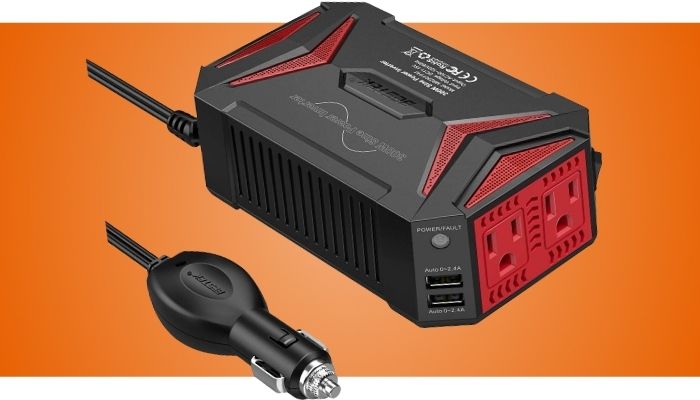
Buy from Amazon
The BESTESK 12V Car Adapter is a compact and powerful adapter well suited for car or RV use. It uses a pure sine wave inverter and includes some really nice safety features.
The inverter itself offers 300W of continuous draw and up to 700W of peak draw. That’s enough to effectively power larger appliances like mini-fridges, TVs, and powerful laptops.
It also includes a pair of USB ports, each capable of providing 2.4A of power. When you consider many 12V adapters only offer up to about 3A of power spread across multiple ports you see why that’s a great feature.
The body of the adapter has a dark black and red design that’s pretty sharp and allows you to put it just about anywhere. It includes a 40A integrated fuse, an automatic fan, and a range of important voltage and heat protections.
If you’re looking for an affordable and reliable 12V adapter the BESTEK is a good choice to make.
Ampeak 100W DC 12V to 110V AC Car Adapter
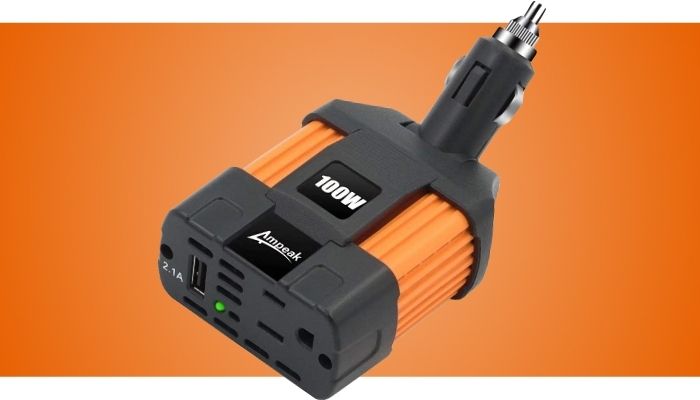
The Ampeak 12V Car Adapter is a fixed position inverter for use in your car or RV. It uses a direct plug design that makes it extremely compact but does limit its usability somewhat.
It has a 100W inverter with a 300W surge capability. That’s just about enough to power things like laptops, tablets, and other small electronics.
Portwise it has just a single AC plug and one 2.1A USB port. Give its relatively low power rating this is a good arrangement.
We thought we were going to dislike the lack of a power cord but were pleasantly surprised. It plugs directly into your dash cigarette outlet and just kind of hangs there. It makes it harder to use if you’ve got shorter cords on your devices but overall made it a lot easier to keep things organized.
If you’re looking for a basic way to charge up a laptop or similar device from your dash DC outlet the Ampeak 100W provides just enough power in a very compact package.
BESTEK 150W Power Adapter with 2 USB Charging Ports
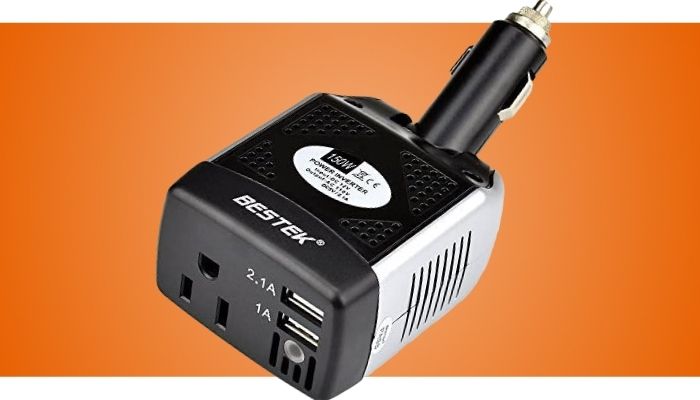
The BESTEK 150W is a fixed plug 12V adapter capable of powering a few small devices. It has a pair of USB ports and a single AC outlet.
The inverter offers 150W of power plus a 360W surge for starting up larger devices. This is a really nice sweet spot between the smallest 12V adapters and the larger 300W+ models.
It’s just right for powering a laptop, small fan, or similar device. The two USB ports offer 2.4A and 1A respectively and allow you to charge up a tablet and another smaller device at the same time.
We were really impressed with the integrated safety features. Despite its small size the BESTEK 150W includes a cooling fan plus automatic shutdown sensors in case of an overload or overheating.
All in all the BESTEK 150W is a good product if you want to power up your AC devices while driving without drawing on the battery bank of your RV.
Giandel 300W Pure Sine Wave Power Adapter
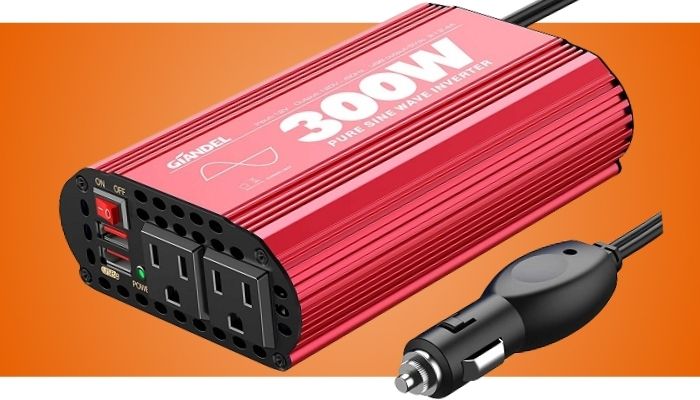
The Giandel 300W is a classic 12V power adapter built for RV and car use. It provides you with a pair of AC outlets and two USB ports for charging a range of devices.
The purse sine wave inverter is rated for 300W continuous and 600W surge. That’s enough to power some larger devices like a DC mini-fridge or a pair of laptops.
We really liked that each of the two USB ports was rated at 2.4A. That allows you to charge a pair of modern smartphones or tablets much faster.
From a safety perspective, the Giandel also gets high marks. It uses an externally accessible 35A fuse and comes with a pair of spare fuses. This protects you from the worst results of a short circuit and allows you to quickly get your adapter back up and running.
The Giandel 300W is a reasonably priced and well-made 12V adapter. It offers dependable performance plus the flexibility to be used in multiple situations.
POTEK 500W AC Car Converter with Digital Display
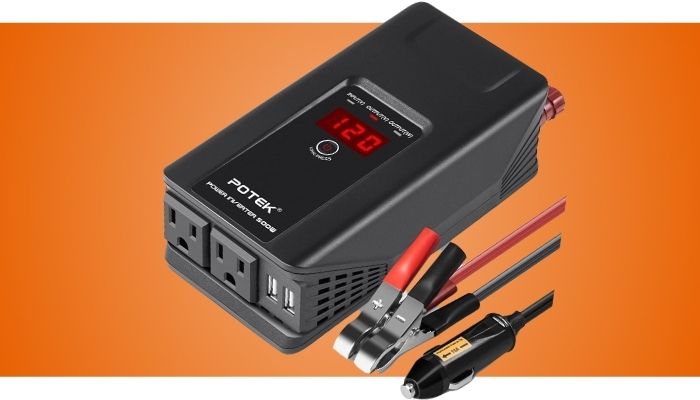
The POTEK 500W car adapter is a powerful and versatile tool for an RVer. It’s designed for use with both standard cigarette outlets and a direct connection to a 12V battery system.
We loved the capacity of its inverter. It can provide 500W of continuous draw and fully 1000W of surge. That’s enough power to run laptops, medical devices, mini-fridges, and other small to medium DC appliances. One thing to keep in mind though is that maximum power can only be provided through a direct connection to a battery.
Some other features we liked were the builtin digital display and comprehensive safety features. The display provided useful information like the input voltage, output wattage, plus safety warnings.
If you’re looking for a higher powered 12V adapter capable of running off both a cigarette outlet and a direct battery connection, the POTEK 500W is a dependable choice.
Energizer 500 Watts Power Adapter
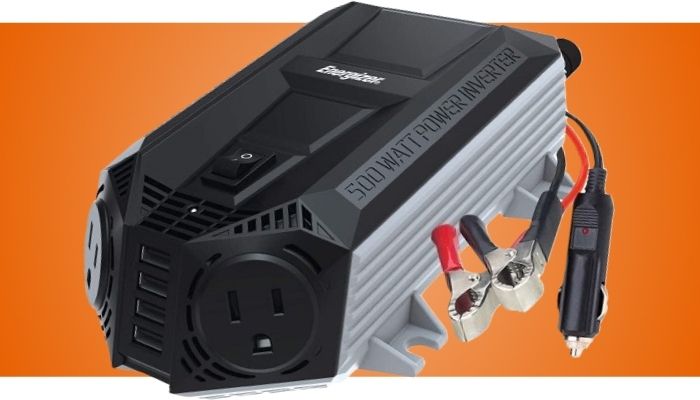
Energizer is a well known brand in the battery and consumer electronics market. What many don’t realize is they also offer a full line of inverters, adapters, and other 12V gadgets.
Their 500W power adapter is capable of connecting to your cigarette style outlet or directly to a battery bank. This allows it to achieve up to 500W continuous power and a surge of up to 1000W. That’s enough power to run appliances all the way up to small air conditioning units.
It has two 110V AC outlets and four USB ports. Each is capable of producing up to 2.4A even when all four are in use. That’s a lot of charging capability for things like tablets and smartphones.
It includes an ultra quiet cooling fan plus a comprehensive range of key safety features. While it is a bit bulky, we think it makes up for it with its excellent performance.
Overall the Energizer 500W power adapter is a robust and powerful charging option for your RV or car.
Best AC to 12V Adapters

One stumbling block to a full-time RV life is how to power your DC appliances if you take some time off the road. If you’re visiting family or renting a place for a month or so it’s nice to be able to use your existing DC TV, refrigerator, and other appliances.
One great workaround for that is an AC to DC adapter. This allows you to power your DC appliances with a standard AC house outlet.
We picked out some of the best AC to DC adapters to help you find the perfect one for your power needs.
Sunforce AC/DC Power Converter
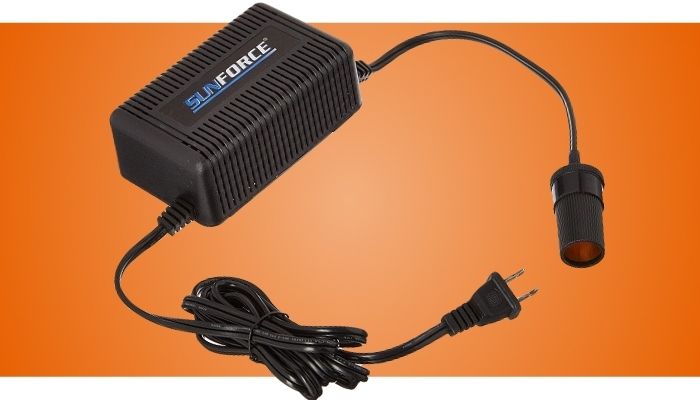
The Sunforce AC/DC Power Converter is a compact converter that allows you to run DC appliances in your home. It’s a bit lower powered than some other converters but does a good job for lower powered devices at a budget price.
It’s dead simple to use, just plug it into the wall and plug your appliance in, and it’s reliable. It produces just under 6A of power. That’s not enough to run larger appliances but works for many smaller devices.
Make sure and double check what the amp draw of your device/appliance is before purchase.
If you’re looking to save a few bucks and still effectively power small devices, the Sunforce AC/DC power converter is a great option.
Schumacher 12V Power Converter
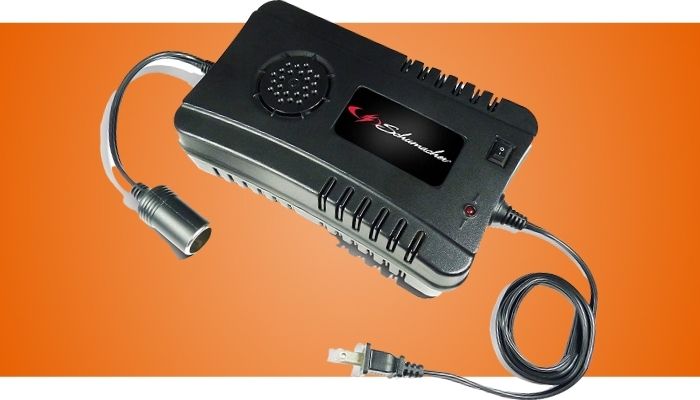
The Schumacher 12V power Converter is a more powerful and portable converter. It’s capable of providing up to 15A of usable 12V DC power, perfect for running higher draw devices like pumps and small appliances.
It’s a bit on the bulky side but given its performance we’ll let that slide. We loved that it included an on/off switch. This lets you leave it plugged in when not in use without having it draw power from your home or other outlet.
While the Schumacher 12V Power Converter is definitely on the pricier side of the market it does provide more power than most comparable converters.
RoyPow AC to DC Adapter 12V Car Cigarette Lighter Socket
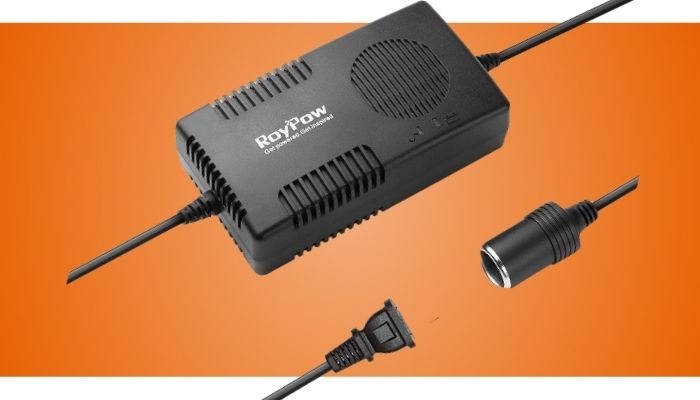
The RoyPow AC to DC Adapter is a light and portable adapter designed for use with a car or RV. It’s capable of providing about 10A of 12V power for DC devices like vacuums and compressors.
This is great if you’ve got some tools you use with your RV that plug into a DC port but want to run them on AC power. It lets you save your battery bank while at a campsite without having to plug fully in.
Overall the RoyPow AC to DC adapter is a good option for those looking to use their DC tools and appliances without having to run a DC power source.
Cellet Universal AC Wall to DC Car Cigarette Lighter Port
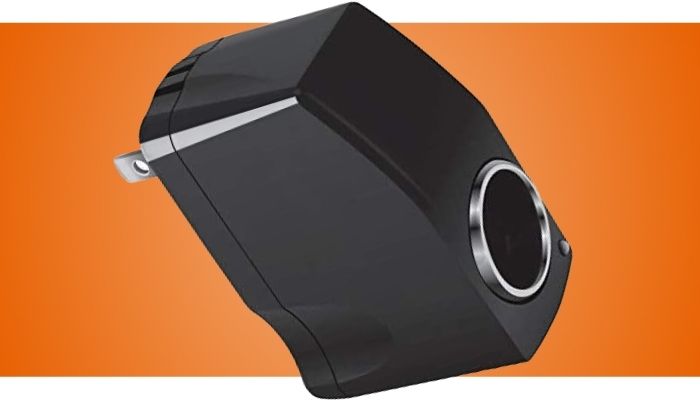
The Cellet Universal AC to DC adapter is an ultra portable device that can help simplify your charging needs. If you’re a full time RVer it can be annoying having to switch between AC and car style chargers.
The Cellet is rated to provide up to 2A of 12V power, enough to let you plug your DC phone charger in. This simplifies the number of cords you need to keep on hand and helps you better organize your charging needs.
While the Cellet adapter is too low powered for any kind of appliance, it can offer a useful solution for charging up devices with just a standard car style charger.
Yelesley AC to DC Car Cigarette Lighter Socket Converter
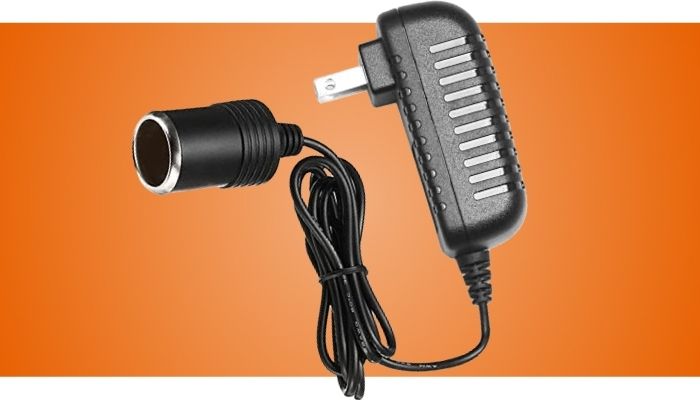
The Yelesly Converter is a compact and convenient device. It looks a lot like an old school phone charger with a cigarette lighter style port on the end of the cable.
It’s rated to provide up to 3.8A, just about enough to power small air pumps or vacuums. That makes it pretty perfect for those looking to simplify the number of basic appliances they need to keep on hand.
Given its extremely affordable price and reliable performance we think the Yelesly Converter is a great option for those with lower power demands.
What is a 12V Adapter
12V adapters are compact and lower-powered versions of standard 12V inverters. They’re designed to take 12V DC power and provide you with usable house standard AC power.
Adapters technically are inverters, but they aren’t the same as the larger house/RV inverters that need to be permanently wired into a DC power system. 12V adapters plug directly into a standard DC cigarette outlet style port and provide AC power for small electronics such as computers as well as basic appliances.
Buyers Guide
Picking out the best 12V adapters comes down to where and how you intend to use it. You have to consider how much power you require and how many devices you want to operate at a single time.
There are also some extra features to look at that can help improve overall usability.
For the kind of adapters we’re talking about prices are generally quite low. You can get ones powerful enough to charge a single large electronic like a laptop for less than $50.
For a bit more capacity, such as the ability to power TVs, mini-fridges, etc, it’s still usually well under $100.
Number of Outlets
The number of outlets on a 12V adapter affects how many things you can charge at one time. Basic adapters often only have a single outlet while larger and more powerful ones offer two or even three.
An important thing to keep in mind is that no number of outlets can distribute more than the approved wattage. Think about what you want to power from your adapter and figure out what percentage of its total output that will draw.
It doesn’t really matter if you’ve got a three or even four outlet 12V adapter if a single appliance draws 90% of its available power.
USB ports are a value add we really like to see on 12V adapters. They allow you to charge all kinds of phones, tablets, and other small electronics without having to break out another AC cord.
Most modern 12V adapters will come with at least one or two of these, though some offer as many as four to five. Realistically though the power they’re capable of providing doesn’t scale much above two USB ports.
Cord Length
The length of your 12V adapter cord affects where and how you can use it. Most come with at least a two to three foot long cord with some substantially longer.
A longer cord allows you to plug into your RVs DC battery banks and power standard household devices indoors and outdoors. It’s a much more affordable way to use your existing systems without purchasing a more comprehensive and permanent inverter option.
Pure vs Modified Sine Wave
12V adapters include small inverters that actually do the work of changing 12V power into 110V AC. Picking between a pure sine wave and modified sine wave inverter affects performance, price, and what you can charge.
Modified sine wave inverters are cheaper but less capable. The power they produce isn’t quite as clean and may damage sensitive electronics. Pure sine wave inverters cost a bit more but produce a much cleaner and more efficient form of power.
Design and Materials
The materials used in 12V adapters are pretty much the same for the body and outlets themselves. The cord used and the internals can greatly change the performance and safety of a 12V adapter.
We like to see copper wiring, isolation voltage protection, and a cooling fan if possible. The physical layout of the adapter can also affect its usefulness.
Adapters that distribute the ports and outlets across their body are easier to use when charging multiple devices.
Intended Use
What you intend to use your 12V adapter for and how many devices it needs to power are major factors to consider. Different adapters offer different operating and surge wattages. This determines how much power they can provide and what type of devices they can power.
You should also think about where you intend to use your 12V adapter. If you intend to power things that are outside your RV you need to know how far away they’ll be from an outlet, what kind of draw they have, and how long they’ll be running.
Some 12V adapters, especially the more value-priced models, aren’t intended for continuous operation. How long they run for and at what level can cause them to overheat.
Top 12V Adapters Video
Final Thoughts
With 12V adapters it really comes down to power and safety.
You want to pick out a model with a good safety record that still has enough capacity to power the devices you need.
So long as you know what you’re powering and what kind of capacity your vehicle battery system can offer it’s easy to pick out the best 12V adapter.
About The Author
Karan Riley

Is There Such a Thing as a 12V RV Air Conditioner?
Most modern RVs include a 120V AC air conditioner that needs either shore power, a generator, or an inverter if operating on batteries. Switching to a 12V RV air conditioner, on the other hand, may minimize power usage.
We’ll look at some of the things you should know about operating a 12V air conditioner in your RV, as well as some of your alternatives, in this post. Let’s get a bit more into this.
Why Do RVers Need A 12V Air Conditioner?
A 120V AC power outlet is used by most RV air conditioners. The snag is that you’ll need an inverter to convert the 12V DC electric charge from your RV batteries to 120V AC electricity for the air conditioner to work. This will result in further electrical losses and even more heat, which is exactly what you’re wanting to avoid.
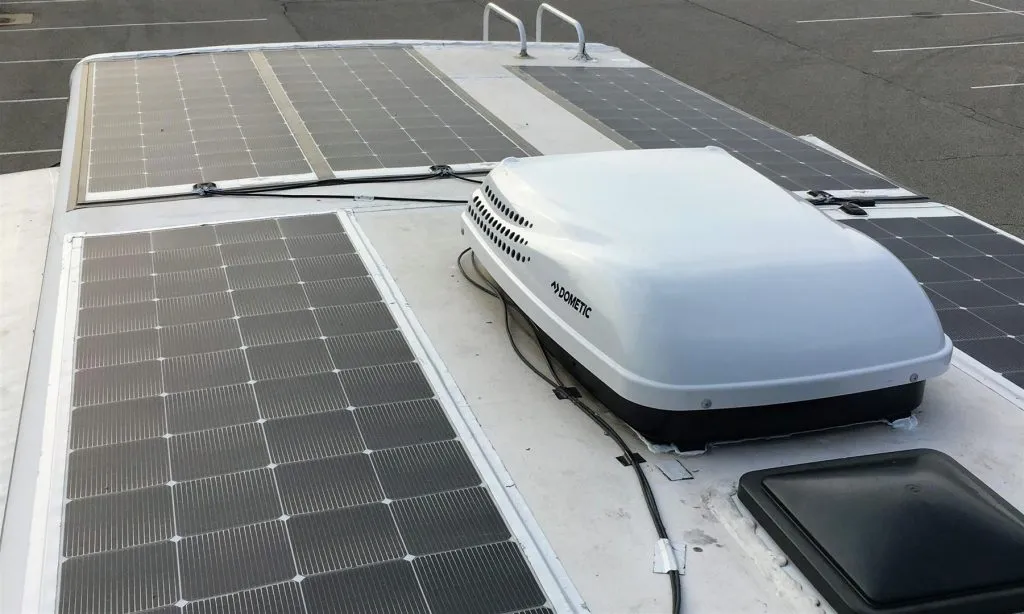
If you don’t have an inverter, you’ll need a generator to power your RV’s 120V AC air conditioner . A generator is an useful backup option, but the noise it produces may be a nuisance, particularly if you’re boondocking late at night.
On the other hand, a 12V RV air conditioner may be powered straight from your battery without the need of an inverter. Aside from that, a 12V DC RV air conditioner is more energy efficient, particularly when running on a battery, since you won’t lose a percentage of the converted power via the RV inverter.
Air Conditioner with a Battery
The trouble is, unless you have a generator or a solar system, it’s difficult to operate a 120V AC air conditioner continuously when the engine/generator is off. A battery-operated 12V RV air conditioner, on the other hand, uses less electricity and may run longer when the motor is turned off than a 120V AC air conditioner .
That means you can spend a few hours outdoors and return to a cool RV. Not to mention, if you’re staying in a public campsite, you won’t be bothering your neighbors all night with a noisy generator.
The Downsides of 12V Air Conditioners
The current draw is the major disadvantage of a 12V air conditioner. In our dwellings, we don’t utilize 12V since the cables would be too big. The wiring for a 12V RV air conditioner must be bigger, and the electronics must be able to withstand greater currents, which might result in voltage dips and efficiency losses.
You’ll need a lot of battery capacity because of the strong currents. This implies that if you want to operate them on batteries overnight, you’ll almost certainly need to invest in lithium batteries.
When it comes to running 12V air conditioners from shore power, the excessive current demand rears its head once again. You’ll need a high-current converter or an inverter charger for this. This also implies that if you run the air conditioner aggressively, your batteries will charge slowly.
As a result, 12V air conditioners are best suited for smaller RVs with reduced cooling needs. In a bigger RV, 24, 48, or greater voltage units are likely to be the best choice.
Recommended reading : Best RV Air Conditioners of 2024
Do 12V RV Air Conditioners exist?
Although battery-powered RV air conditioners are not yet common, a few manufacturers have launched them to the market, including Dometic, Nomadic Cooling, Indel B, and Rigid.
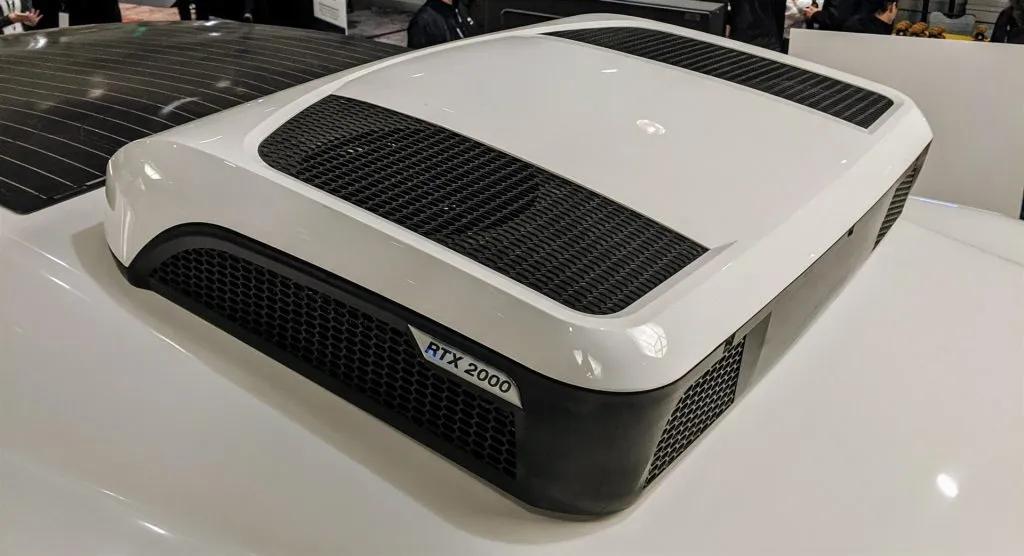
The majority of these cars owe their origins and inspiration to the transportation industry. Truckers who wish to turn off their cars overnight rather than letting them idle to keep them running regularly install 24V air conditioners. These technologies and models have gradually been switched from 24V to 12V to accommodate campers and motorhomes.
Some of the largest 12V RV air conditioners can generate up to 12,000 BTU, which is sufficient to cool most standard-sized RVs. On the other hand, a powerful battery-operated air conditioner would need a deeper dive into your wallet.
A 12V RV swamp cooler, on the other hand, is a cost-effective solution if you’re mostly going to dry locations.
What Is A Swamp Cooler And How Does It Work?
An evaporative cooler, often known as a swamp cooler, works by blowing hot, dry air through a wet cooling pad. The heat is absorbed by the wet pad, which causes the water to evaporate, cooling your RV. Many of these coolers may also operate on 12V electricity.
A swamp cooler is better suitable for dry, arid settings since it raises the humidity level in the air. A swamp cooler, on the other hand, would be ineffective in a humid area.
Air Conditioner vs. Swamp Cooler
Unlike a swamp cooler, which requires water in the reservoir, an air conditioner cools a space using chemical refrigerants. Although air conditioners are more effective at managing temperature than evaporative coolers, the latter uses much less energy.
Swamp coolers are also less expensive and simpler to install than air conditioners.
Recommended reading : 5 Best RV AC Covers and Why You Should Use One
4 Best RV Air Conditioners for 12 Volts
Let’s have a look at some of the top 12V RV air conditioners on the market (air conditioners that utilize compressors and operate on 12V electricity).
#1. RTX Dometic RTX 2000

This Dometic RTX 2000 was developed from a 24V device available in Europe and was meant for truck drivers. We’re extremely thrilled to see a larger RV parts company provide a solution for 12V air conditioning, since it’s a relatively new product on the US market.
On eco mode, this 12V air conditioner can keep your RV cool for 12 hours while drawing just 19 amps. If you need to swiftly manage the temperature, turn on the turbo cooling operation mode and increase the power to 6,824 BTU or 2000W.
It features a small and elegant design that rests only 6 inches above your RV roof once fitted.
#2. Nomadic Cooling 2000 12V
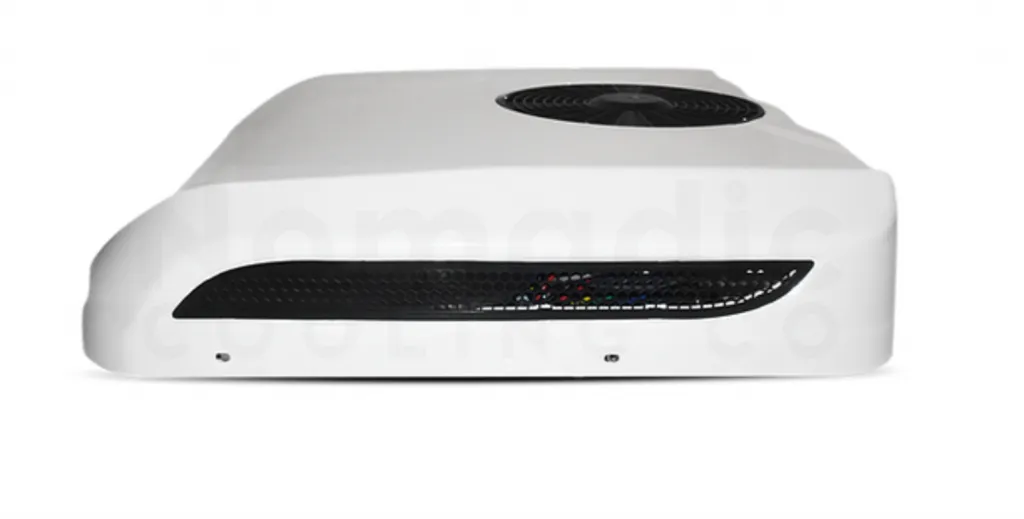
Nomadic Cooling, the pioneers of 12V cooling for vans and campers, produced the Nomadic Cooling 2000 12V RV Air Conditioner. The compressor on this RV air conditioner is 75 amps, yet it only draws 35-40 amps in Eco mode. It has a 9830 BTU cooling capacity.
The Nomadic Cooling 3000 12V Air Conditioner, which is significantly larger, can produce up to 11,830 BTU while using 100 amps.
Furthermore, since it does not vibrate and the noise level is below 60dBA, the sound is unlikely to be distracting.
Fortunately, it includes everything you’ll need to put it up on the roof. These types, on the other hand, offer substantially greater BTU capabilities and would be better suited to bigger setups.
#3. Oblo, Aircon, and Cube 12V Air Conditioners – Sleeping Well
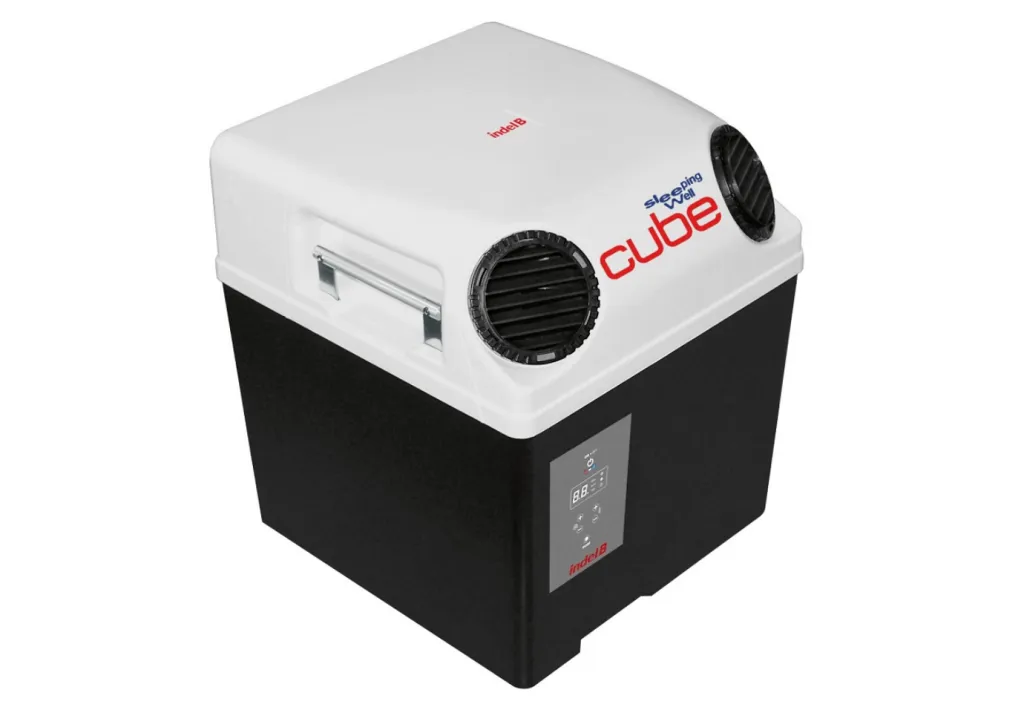
The SW Oblo, the SW Aircon 1600, and the SW Cube are three versions of “Sleeping Well,” or SW, 12V air conditioners made by the Italian manufacturer Indel B.
To provide safe and silent cooling, these units all employ the highly efficient 12V Direct Current Secop (previously Danfoss) compressor. The air conditioners have two modes: Turbo and Eco. The cooling capacity is 3250 BTU.
Unfortunately, these models are not readily accessible from a major distributor in the North American market. If this is the route you want to go, you’ll most likely need to figure out how to ship/import from a European distributor, and here’s one in the UK you may check into.
#4. 12V Compact Refrigeration Cooling Systems
The Rigid 12V Cooling System is more of a do-it-yourself 12V air conditioning system. A driver board, condenser, capillary small rotary compressor, and evaporator are included in this kit.
It has a cooling capacity of 1535 BTU despite its maximum power input of 150W. As a result, it’s best suited to extremely tiny, compact campers, such as off-road campers and vans. It might even be used to cool a single room in a medium-sized RV.
Recommended reading : Best Air Conditioner For A Campervan of 2024
12V Air Coolers for RVs (Evaporative Or Swamp Cooler)
If you reside in dry areas, owning a swamp cooler has a few advantages. Consider the following choices if you desire 12V RV swamp coolers.
Turbokool 2B-0001 White 12 Volt Evaporative Swamp Air Cooler
With the purchase of a metal vent frame, the Turbokool 2B-0001 12 Volt Evaporative Swamp Air Cooler may be roof-mounted over an existing 14′′ x 14′′ roof vent or can replace an existing RV air conditioner.
Turbokool’s creators claim that it can chill air by 20 to 30 degrees while only using 4.6 amps of 12v electricity.
It is not suggested for use in areas where the average relative humidity exceeds 75%, and you should anticipate performance to degrade as you move closer to that 75% threshold.
MightyKool The K2
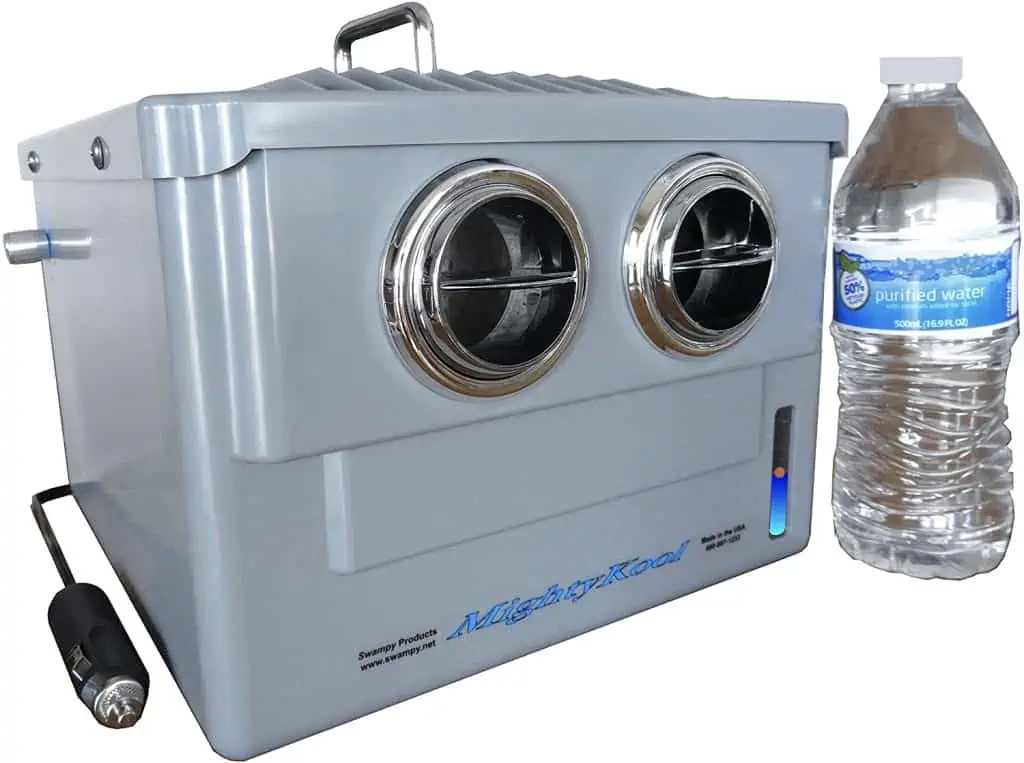
This MightyKool Swamp Cooler is a 12v swamp cooler, not an air conditioner. In fact, the manufacturer will not give it to you unless you confirm that you understand what you’re purchasing!
Make careful to read the reviews and don’t expect it to achieve anything it isn’t capable of. Swamp coolers are best used in arid regions.
This model comes with two cool air vents that can blast humidified air at a speed of 25 miles per hour. It evaporatively cools humans and pets in non-moving compact enclosures like RV campers using water (any temperature) rather than ice.
Is 12V RV Air Conditioning the Way of the Future?
Although 12V RV air conditioners may not have the same power as 120V air conditioners, they are an excellent choice for a compact RV. These devices may be costly, so examine the benefits and drawbacks before purchasing.
With the increased interest in boondocking off-grid and the availability of lithium RV batteries, 12V air conditioners are gaining appeal in general. In the next years, we fully anticipate to see additional firms and models enter the market to accommodate the need for more efficient air conditioning.
Published on April 24, 2024
Meet Bob & Sarah

We're Bob & Sarah, the RVers behind RVing Beginner. We love RV travel, useful gear, and all things nature. Read more…
Popular Content
Best rv air conditioner, best air conditioner for pop up camper, best air conditioner for campervan, best portable air conditioner for rv, best 12v rv air conditioner, smallest portable air conditioner for rv, best quiet rv air conditioner.
About Us - Contact Us - Privacy Policy - Terms Of Service - Affiliate Disclosure - Sitemap
Copyright © RVing Beginner 2022


This post may contain affiliate links or mention our own products, please check out our disclosure policy .
RV Electricity Made Simple: All About Volts, Watts, and Amps
Published on January 31st, 2023 by Brian Newman
Understanding RV Electricity Basics Can Keep You Safe
Throughout your life, you’ve heard the terms “amps,” “volts,” and “watts” concerning all things electrical. When you started RVing, the sales rep told you that your RV electrical system is a 30 or 50-amp. For most, all that means your RV electricity cord has three or four prongs.
Now that RV electric systems can go off-grid, RVers wanting to take advantage of this technology need to start paying attention to these RV electric terms and know how they apply to their coach.
In part 2 of our RV Electricity Series, we’ll discuss the three measurement terms of electricity and how they apply to RV electric systems. Now more than ever, these electric measurements are vital for off-grid RVers that use onboard electric generation devices for camping adventures. It can also come in handy for those with 30 amp RVs, limiting how many devices they can run simultaneously.
DON’T MISS OUT ON CAMPER SMARTS UPDATES
Sign up for the newsletter today.
Please enter a valid email address.
An error occurred. Please try again later.
Thank you for subscribing to the Camper Smarts newsletter, keep your eye on your inbox for updates.
What we know about ac/dc power.
In Part 1 of our RV Electricity Series , we discussed the difference between an RV’s Alternating Current (AC) and the Direct Current (DC) systems. For a quick refresher, your RV’s house batteries supply RV electricity to the DC power systems. The power you receive from the power box at the campground provides AC power.
RVs come with a converter (usually installed under or near the refrigerator) that changes the RV’s electricity from AC power to DC to charge your house batteries while you’re plugged in at the campground or elsewhere.
Today, many motorhomes and travel trailers come with an inverter that turns the DC battery power into AC electricity so you can watch TV, power kitchen appliances, and charge your laptop when your RV is not plugged into shore power.
The difference between AC and DC power is due to the flow of electrons. In DC power, electrons flow in only one direction between the positive and negative poles of the power source. With AC, electricity flows back and forth between positive and negative poles using magnets.
All batteries, including your tow vehicle, motorhome’s chassis, and RV house batteries, use DC power. The US electrical grid and your onboard generator supply AC power.
Defining The 3 Characteristics of Electricity
In the above video, the demonstration shows two bags filled with water. The demonstrator places barbell plates of different weights on each one. He then punctures each bag to show a stream of water that the weight’s pressure produces on the bag of water.
The result is that the heavier weight produces a longer stream of water than the smaller version. It’s a good analogy for how electricity works regarding volts, watts, and amps. Fortunately, the same measurements are used whether we are talking about AC or DC power.
1. Voltage (Volt or V)
Volts, or voltage, is the unit of measurement for electric potential difference, or electric pressure. It can also be thought of as the electrical force that pushes the electric charge through a wire. For example, in the demo video, the bigger weight represented a larger voltage because it put more pressure on the water bag.
So once the demonstrator punctured the bags, we saw a bigger water stream compared to the one with the smaller weight. Therefore, in electrical terms, the bigger water stream represented a higher voltage.
AC 120-volt is considered high or standard voltage. Your RV’s electric AC system runs your electrical outlets, RV air conditioners, and residential refrigerator. They need a high flow of energy. When you use an inverter, part of its job is to increase the voltage so these devices can operate correctly.
DC 12-volt systems like your ceiling lights, water pump, and coach heater operate at a lower voltage. When your RV is plugged into shore power, the converter is trickle charging the house batteries. So everything on the DC power grid receives power from the house batteries directly.
Please note that we’re keeping it simple, so we’re not factoring in a solar system or generator for this discussion. The following video has a more in-depth explanation of volts if you want to dive deeper into the subject.

2. Amperage (Amp or A)
Amps, or amperes, are the unit of measurement for electric current. Or, to put it another way, it’s the amount of electricity flowing past a particular point. Just like water flows through a pipe, electric charge flows through a wire. The rate at which the water flows is measured in gallons per minute, and the rate at which the electric charge flows is measured in amps. The more charge that flows through the wire in a given amount of time, the higher the current in amps.
Your RV’s electric system is rated at 30 or 50 amps. Unlike voltage which remains pretty constant at between 110-120V, when plugged into shore power, the amperage flowing through your RV electrical wires depends on how much power is being consumed by the various devices you are running. Anything that requires big motors or contains resistive elements intended to generate heat will require more power to run, therefore, will draw more amps.
Whether it’s the rooftop air conditioner, electric jack controller, or running your plugged-in Insta-Pot, the whole RV electric system needs the amp strength to keep the power hogs working efficiently while still having enough left over for the smaller electrical appliances and equipment.
To calculate amps, use the following formula:
Amp Draw (amps) = Power (watts) / Voltage (volts)
So to calculate the amp draw of a 1000W microwave, it would look like this:
1000W / 120VAC = 8.33A
So if you’re figuring out how many things you can run in your 30 amp RV, you can round the above number up to 9 and know that the combined amperage of other devices you can run along with the microwave can’t exceed 21 amps. Using this formula, it’s pretty easy to determine why a 30 amp rig might be able to run a 1000W microwave and a 2000W air conditioner for a short time which will pull about 26-ish amps, but if you turn on a 1200W coffee pot at the same time, you’ll trip breakers.
Electrical Safety: Amps + Volts Can Kill
Many people have heard that the amps can kill you in electricity, not the voltage. While this is true to some extent, it isn’t the whole picture. 12V batteries found in cars and RVs can deliver more than enough amps to kill a human (just 1 one amp can do it), but we don’t hear about car batteries zapping unsuspecting weekend mechanics into oblivion. The reason is the low voltage. Twelve volts just isn’t enough electrical pressure to send the electricity throughout your body. But remember, it is enough to be painful and cause burns under the right circumstances.
On the other hand, the electrical power coming from a 120V source is way more than enough to send that current into your body, and anything over 0.15 amps (150 milliamps) can cause severe injury or death. Keep in mind that just because an electrical circuit can put out 30 or 50 amps, that doesn’t mean it will have that many amps flowing through it all the time. Everything from the dryness of the person’s skin, what part of the body touches the electrical connection, and the path it travels through the body will determine a fatal shock from an uncomfortable one.
Can Voltage Throw You Across A Room?
We’ve all seen the TV trope of high-voltage sources throwing people backward. However, this is not entirely accurate; the power doesn’t launch people through the air. Electrical current above 6 to 30 milliamps (that’s thousandths of an amp) can cause the body’s muscles to contract involuntarily. Sometimes, that may cause a person’s hand to clamp onto an electrical source and be unable to let go. In other cases, the leg muscles are activated, which can cause a person’s body to throw itself. Regardless of the mechanism that causes them to be thrown, the end result is a possible blunt-force injury.
To better explain this, I have a friend who worked as a junior manager on a construction project. His boss asked him to look, not touch, the electrical connection on the top of a structure the company was building to verify everything was adequately secured.
Well, like a 5-year-old, he touched it, and it threw him 8 feet from the connection. Luckily he was okay and didn’t fall off the roof. Did I mention he was college educated with an engineering degree?
Had he been crouched or had different muscles been activated when he touched it, it may have been enough to send him off the roof, even if he didn’t receive a fatal shock. By the way, I did make sure to remind him how that college education was money “well spent” in a way only best friends talk to each other.
Motorhomes and travel trailers don’t have 440 amps flowing through them, but you can still injure yourself when working on the RV electric system. Ensure you disconnect the chassis and house batteries, and unplug from shore power whenever you work on your RV’s AC or DC system.
3. Wattage (Watts)
A volt measures “electrical pressure.” Amps measure how much electricity is coming out. Wattage measures the power. It answers the question, “how much overall energy is needed to operate the RV electrical device in question.” To answer that, it’s expressed in a simple equation:
voltage x amperage = wattage

For example, the Duxtop Induction Cooktop needs 120 volts and 15 amps to work correctly. When you multiply both of those numbers, it equates to 1,800 watts.
4. Watt-Hours (Wh)
1000 watts is referred to as a kilowatt. RVers who stay at long-term parks or monthly can be billed for their electrical usage in kilowatt-hours. Watts are often confused with watt-hours (Wh). Think of it like the speedometer vs. the odometer of a car.
Watts are like speed. You can travel at 25mph or 100mph, and the odometer doesn’t really care. It just logs how many miles total you have driven. If you drive 25mph for four hours or 100mph for one hour, your odometer will read 100 miles either way. It’s the same relationship between watts and watt-hours.
You can calculate the kWh usage of an appliance with the following formula:
Appliance Wattage (W) x Running Time = Power Consumed (Wh or kWh)
So a 2000-watt (2kW) air conditioner running for 5 hours a day would consume 10kWh of power per day.
2kW x 5 hours = 10kWh
Why Do RVers Need To Know About Amps, Volts, And Watts?
It’s very common for RV owners to show up to a campground, plug their rig into the socket that fits, and run appliances like they’re in a residential home. Those same RVers may wonder why their breakers are always tripping when they try to cook breakfast too.
When it comes to RV electricity, whether it’s figuring out your off-grid solar needs, daily electrical consumption needs, or any RV electricity issue, it’s important to know how electricity works. This knowledge can help you determine how many and what appliances you can run at once safely, especially if you have a smaller 30-amp rig. With the equations above, you can look at the sticker or stamp on any appliance you own and determine the device’s wattage and amperage.
If you’re heading out on a boondocking adventure, lot-docking on your way to your destination, or bouncing from one Harvest Hosts location to another, you need to know how to read and understand your RV’s electrical vital stats to keep the power going.
In a “better case” scenario, running out of RV electric power could mean no more TV, you can’t charge your mobile devices, and your RV refrigerator won’t keep your food cold anymore.
The “worst-case” scenario is that you lose medication that needs to stay cold, you can’t sleep in the 105°F temperature because the air conditioner won’t work, and the water pump stops drawing water in the bathroom (don’t ask, I don’t want to talk about it).
Knowledge is (Electric) Power
If you need help finding the amps, volts, and watts of a specific device, there should be a label on it that lists the measurements. For example, per the photo below, the oscillating fan we’ve used for years in our motorhome uses 120 volts. It has two- prongs and plugs into the 120-volt AC ports. On hot summer days here in Florida, it has helped move the cool air conditioning around our coach space wonderfully.
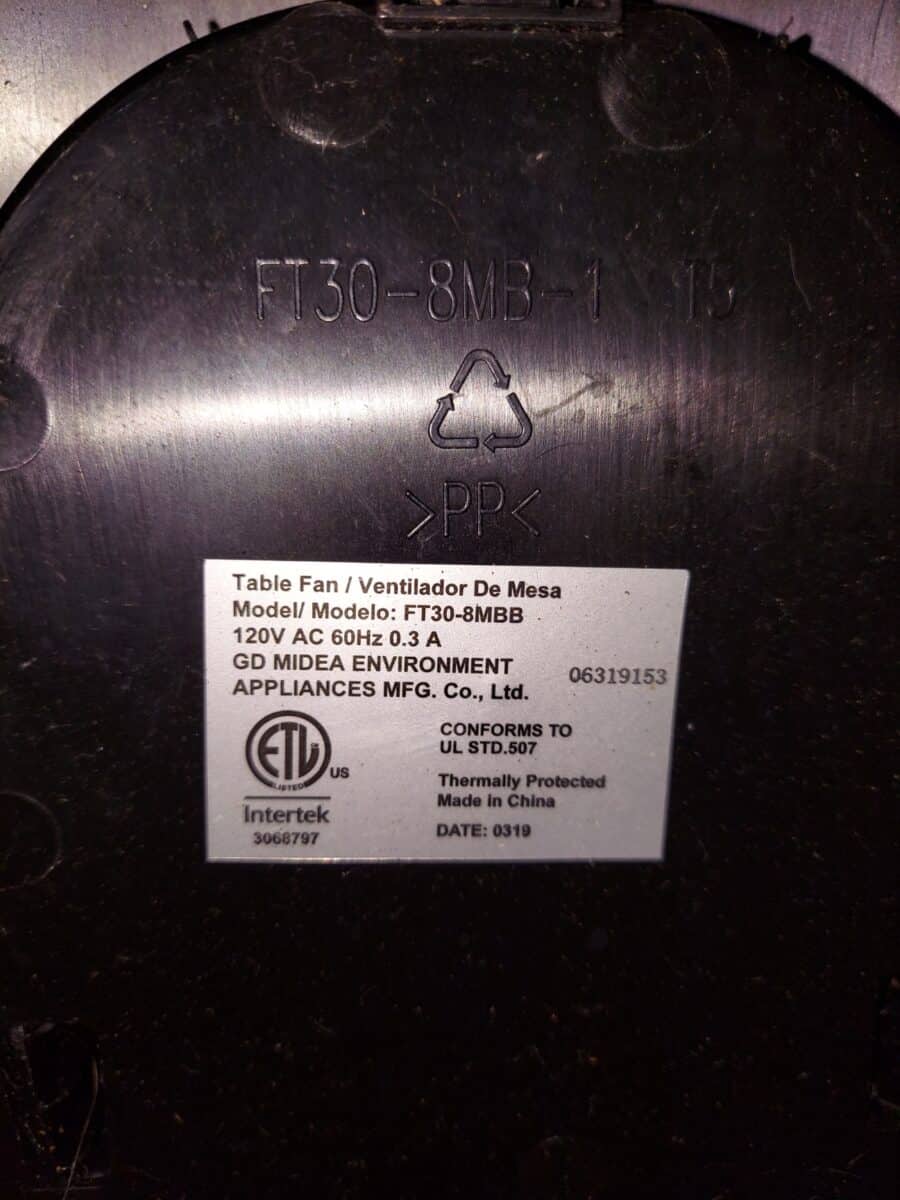
The amperage and watts are very low, so when we’ve been on the road, existing on battery or generator power, the fan has been a lifesaver.
For those looking to add a solar panel and bigger batteries to their RV electricity systems , you’ll need to know the amp, volt, and watt specs of everything. Solar panels are the slowest electric-generating devices, and their reality differs from their reputation. To learn more about RV solar systems, check out our discussions:
- How Much Solar Power Do I Need For My RV
- RV Solar Power For Air Conditioners
- Save Money This Winter With a DIY Solar Air Heater
Maintaining your electrical system Is Important
RV LIFE Maintenance is a cloud-based service that is part of the RV LIFE Pro subscription. It works on your tablet, computer, and smartphone. Use it to track upcoming maintenance dates and get detailed reminder emails showing what needs your attention and also the last time you performed that task, its costs, and related documentation. It also turns data into reports that let you access documents and see key dates instantly. Learn more!
Share this post:
Related posts:.

How to Install an Inverter in Your RV: A Step-By-Step Guide
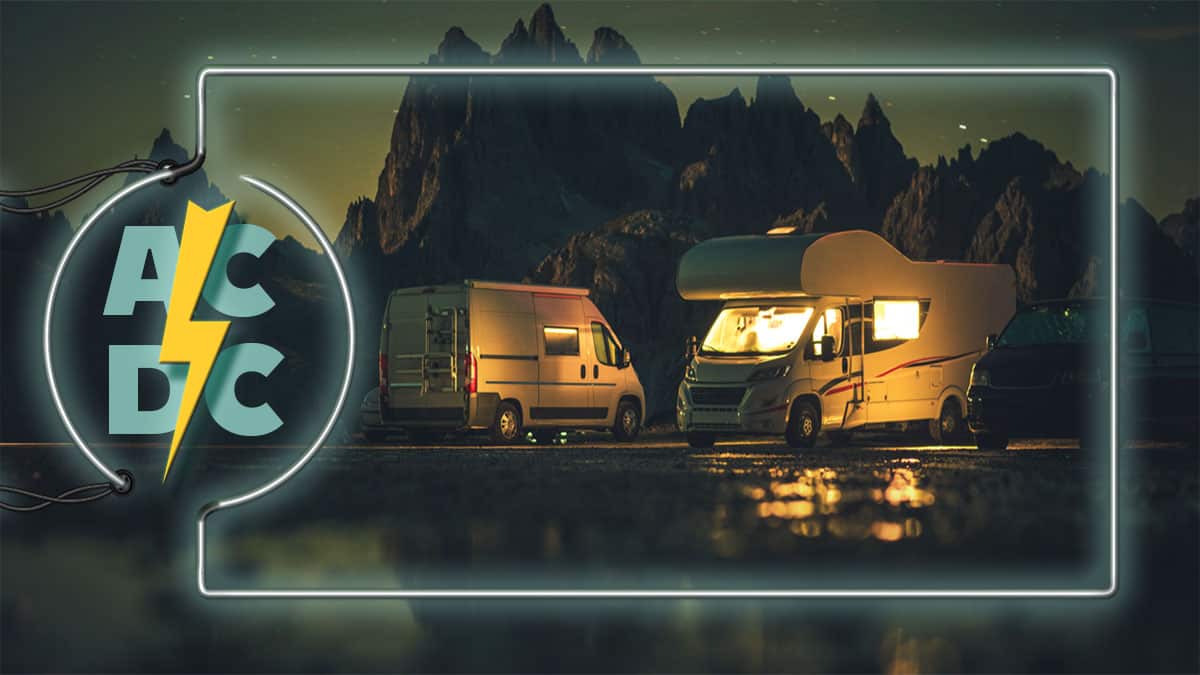
RV Electricity Made Simple: AC And DC Power Basics
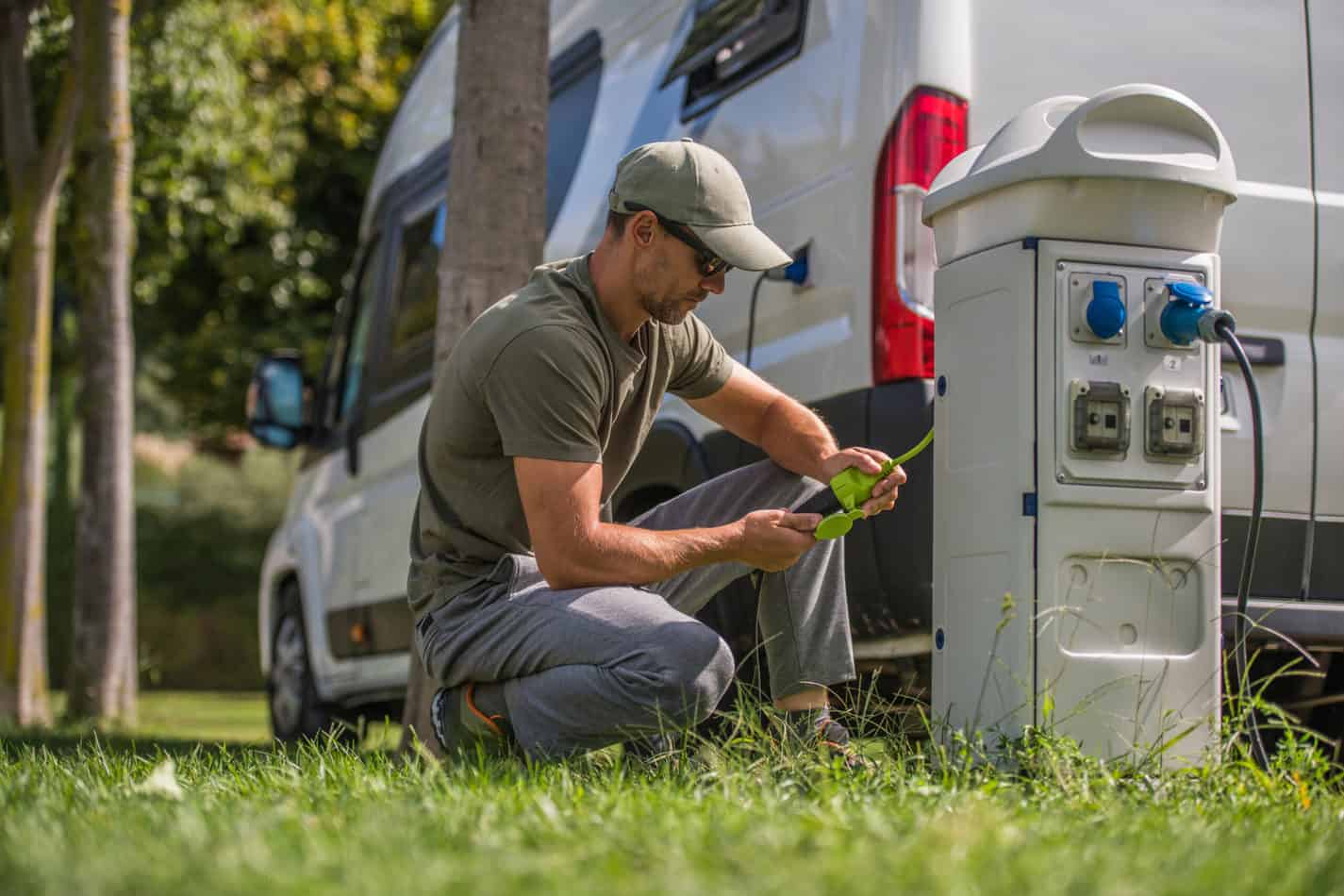
RV Converter VS Battery Charger: What’s The Difference?
About the author:.

Brian Newman and his wife joined the full-time RV lifestyle in 2017. Brian has been a freelance writer since 2019 and has a diverse background that includes literature, religion, business, finance & investment, disability, recreational vehicles, and U.S. history.
Follow Camper Smarts:
- Follow Us On Facebook
- Follow Us On Twitter
- Follow Our Pins
- Скидки дня
- Справка и помощь
- Адрес доставки Идет загрузка... Ошибка: повторите попытку ОК
- Продажи
- Список отслеживания Развернуть список отслеживаемых товаров Идет загрузка... Войдите в систему , чтобы просмотреть свои сведения о пользователе
- Краткий обзор
- Недавно просмотренные
- Ставки/предложения
- Список отслеживания
- История покупок
- Купить опять
- Объявления о товарах
- Сохраненные запросы поиска
- Сохраненные продавцы
- Сообщения
- Уведомление
- Развернуть корзину Идет загрузка... Произошла ошибка. Чтобы узнать подробнее, посмотрите корзину.
Oops! Looks like we're having trouble connecting to our server.
Refresh your browser window to try again.
Here is Why RV Air Conditioner Won’t Turn On?
by Chris Coleman
www.rvtalk.net is reader supported. When you buy through links on our site, we may earn an affiliate commission.
The air conditioner system in your RV could show many problems like making noises , not blowing cold air , leaking water, and more. But it also may happen that the RV air conditioner won’t turn on sometimes.
Most people may think they have to replace the whole unit since the old one is acting dead. However, there are still ways to find out the source of this problem and do the RV air conditioner troubleshooting.
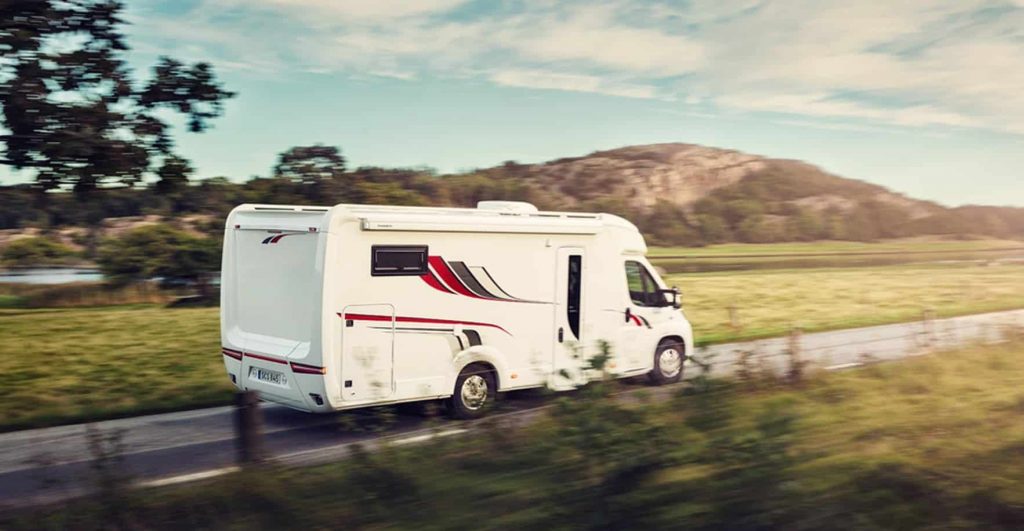
Examine the AC’s Power System
Wiring issues, faulty motor or compressor, check the thermostat, dirty components, low on refrigerant, ac unit issues: repair or replace, best rv air condition units, rv air conditioner won’t turn on: what are the causes.
An air conditioning system is designed to serve for 10 to 20 years. However, like any electronic device, it can stop functioning or show other issues.
What should you do when the RV AC not working? Check these following components to find out the possible cause.
When the RV AC not turning on at all, you will need to find out if it gets the power supply.
The first thing to look into is the 12V panel if the fuse is blown or the breaker is tripped. The thermostat also draws power from the same panel. If the thermostat also does not work, you can change or repair the power panel.
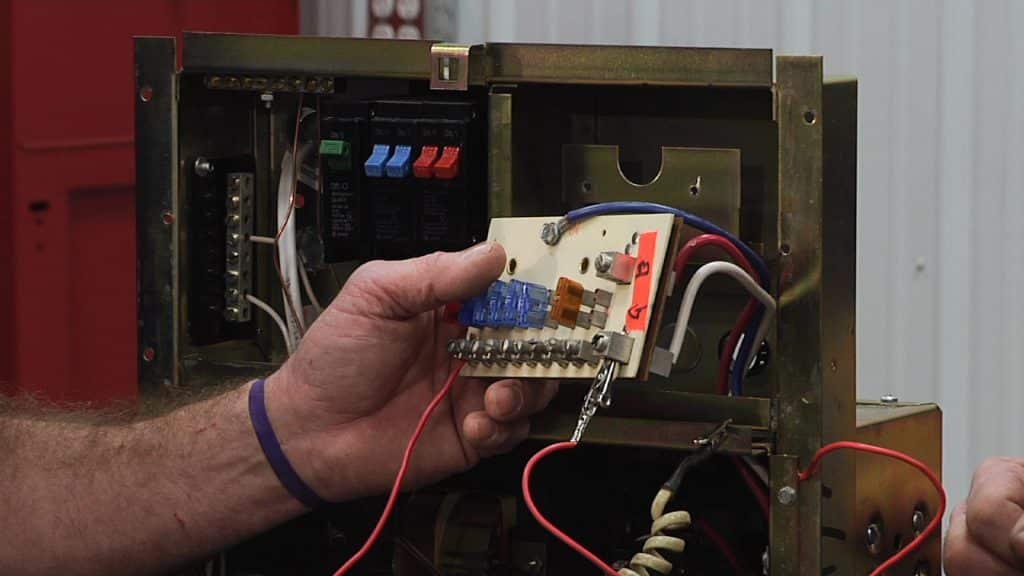
If it is a blown fuse or a tripped off breaker, you simply have to change the fuse or reset the breaker. It may happen when the power supply of your campsite is too weak to power up the AC system. However, this is not a problem in the campgrounds these days as they use a 50A service for modern AC systems. It could happen in the sites that still use the old 15A power poles. However, you should still check the breaker as it can trip for some other reasons.
If the power system is fine and working, you have to check some other components.
The wires that run from the AC unit to the power outlet could be another reason for the RV air conditioner won’t turn on. If this is the case, you should contact a professional HVAC mechanic to handle the issue. Dealing with frayed or dead wires could be tricky and dangerous for amateur DIYers.
The whole system will shut down and won’t start off if the motor is malfunctioning. You need to check the motor to see if the issue is repairable or you need to replace it.
Similarly, problems with the AC compressor may cause the whole system to shut down.
Another reason the RV air conditioner won’t turn on is the faulty thermostat. It is defective if touching its wires to each other turns on the AC system. In the case of a wall-mounted thermostat, use a multimeter to check its voltage.
However, you should examine the AC system’s control board if both thermostat and capacitors are functioning. Even if the thermostat is defective, you can easily replace it. But changing the AC unit’s control board is more complicated and requires professional expertise.
A failed capacitor or contactor is the reason RV AC clicks but won’t turn on . If this is the problem, always hire a professional to do the repair work. Capacitors store high-voltage power and there is a chance to get electrocuted if you attempt any repair.
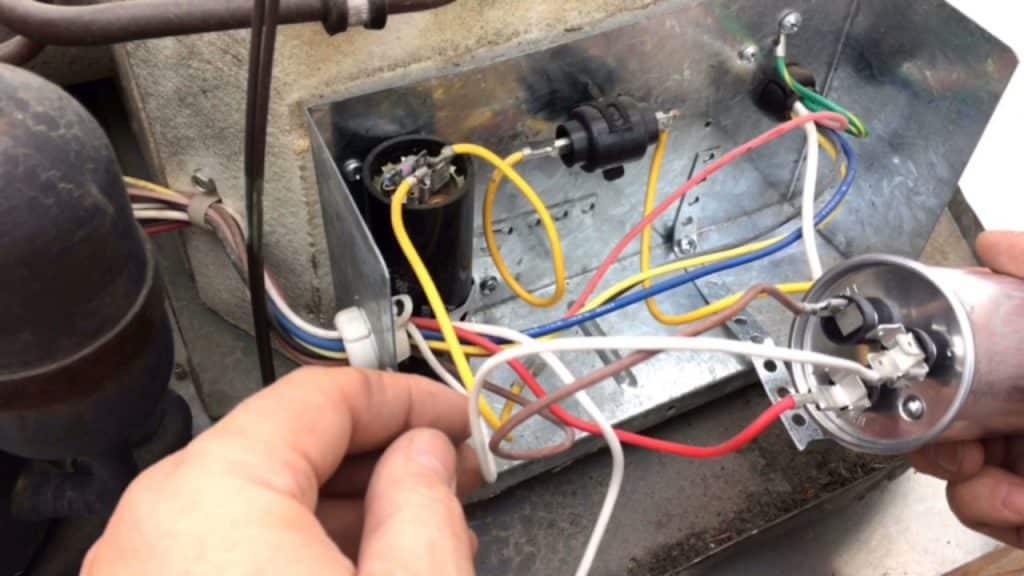
Dirt buildup in several components including filters, evaporators, and the condenser is one of the leading causes of AC system breakdown . Regular servicing and cleaning is an effective way to avoid this problem. If your AC unit has filters, these should be changed when they are dirty or according to the recommended schedule in the owner’s manual.
An air conditioning system won’t work if it is low on refrigerant. Even if it turns on, it is unlikely to function properly. It will be easier to refill if your AC unit uses R410A or R-134A refrigerant rather than the R-22 types. You should ask for professional help for the refill.
Even the most reliable air conditioning system can show troubles. But buying from a renowned brand that has good reviews makes sure that you will get good service and will be covered with a warranty if the unit breaks down.
You will find some of the best RV air conditioners from brands like Coleman, Dometic, Honeywell, and Frigidaire to avoid issues like the RV air conditioner won’t turn on.
Despite checking for the issues mentioned above, if the air conditioner still shows problems, you should ask for the help of an expert HVAC mechanic. If the unit is over 12 years old, repairing won’t be a good option. Even if it is possible to fix, evaluate the repair costs before making the final decision. Buying a new one is the better option if the expense is more than 50% of the unit’s price.
Even the most reliable air conditioning system can show troubles. But buying from a renowned brand or a product that has good reviews makes sure that you will get good service and will be covered with a warranty if the unit breaks down.
To avoid issues like the RV air conditioner won’t turn on, you can try any of these following models:
Coleman Mach 15 . With the option for both ducted and non-ducted installation, this unit offers a high-performance cooling ability. This small powerhouse can cool down your medium or large motorhome even in a desert hot condition.
Honeywell Portable Air Conditioner . If a portable AC unit is what you are looking for, this model is a great choice. Rated at 9,000 BTU, the device also works as a dehumidifier. It also operates quietly, ensuring you a good night’s sleep.
Dometic 640315C Penguin II . This unit packs a punch despite having small dimensions. Rated at 13,500 BTU, you can use it as both ducted and non-ducted systems. Its aerodynamic design creates only a low amount of drag.
Zero Breeze Portable AC . Another portable unit that is great for your home on the wheels. The device is lightweight and rechargeable.
Frigidaire FFRA0511R1 . This AC is a good option if you need air conditioning only for a single room. Running quietly, the device also keeps you safe by sliding out an antibacterial mesh filter. It starts at 5,000 BTU but higher capacity models are also available.
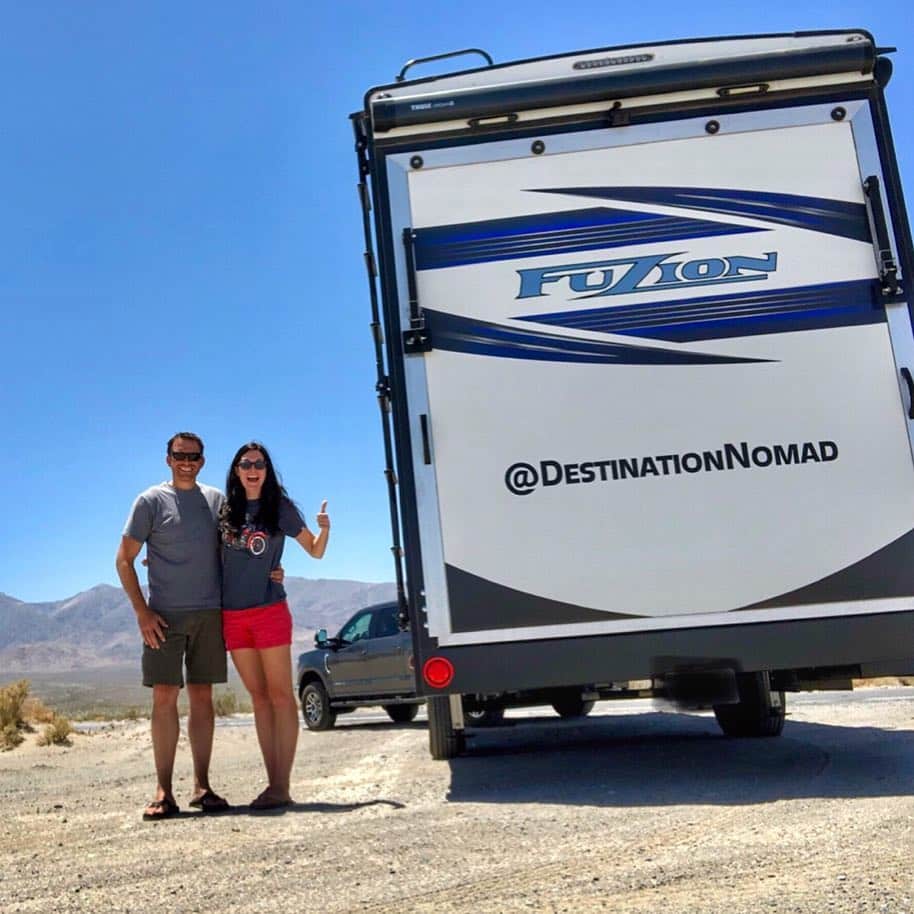
About Chris Coleman
Chris Coleman is an interesting travel blogger and outdoor photographer with a great sense of humor. He owns an RV Accessories shop in New York City so he has the knowledge necessary to provide thorough reviews and give advice on how to choose the right products for RV travel. He puts all that RV knowledge and experience to good use in his sharing posts. Besides product buying guides/reviews, Chris also writes informative articles, how-to articles and RV camping guides in his own interesting viewpoint. Chris’s blog is one of the most reliable information sources for RV campers no matter if you're an expert or a determined beginner.
Related Articles in this Category
6 reasons why an rv air conditioner freezing up, can solar panels power an rv air conditioner, rv ac fan not working: tips for a proper diagnosis, the 12 best portable air conditioners for rvs, campers, how to clean rv air conditioner filter using a 5-step method, troubleshooting rv air conditioner leaks when it rains, the 8 best air conditioners for pop up campers, the 15 best rv air conditioner reviews for 2022, rv air conditioner not blowing cold air: causes and repairs, troubleshooting rv air conditioner compressor not coming on, how to quiet rv ac: the most effective ways, 1 thought on “here is why rv air conditioner won’t turn on”.
A/c and microwave not working and no 115 electric outlets work either. This is with generator running. Help!
Leave a Comment Cancel reply
Save my name, email, and website in this browser for the next time I comment.
- Good Sam Community
- Truck Camper Group
- Re: 12v DC Air Conditioning Conversion Progress
- Subscribe to RSS Feed
- Mark Topic as New
- Mark Topic as Read
- Float this Topic for Current User
- Printer Friendly Page
12v DC Air Conditioning Conversion Progress
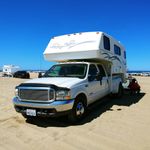
- Mark as New
- Report Inappropriate Content
Apr-30-2024 10:09 AM

- All forum topics
May-05-2024 12:42 PM
May-06-2024 01:03 PM
May-06-2024 02:01 PM
May-06-2024 02:49 PM

May-05-2024 09:36 AM
May-06-2024 01:04 PM
May-07-2024 05:17 PM
May-03-2024 09:17 AM
May-01-2024 05:55 PM

May-01-2024 05:35 PM
May-03-2024 06:24 AM
May-03-2024 06:45 AM
May-04-2024 05:11 AM
never-displayed


Please contact the site administrator

Our expert, award-winning staff selects the products we cover and rigorously researches and tests our top picks. If you buy through our links, we may get a commission. Reviews ethics statement
Best Car Power Inverter for 2022
When you need more power than your car's USB ports can offer, a DC-to-AC power inverter may be able to provide enough juice for gadgets and appliances.

- North American Car, Truck and SUV of the Year (NACTOY) Awards Juror
Whether you are in one of the more modern cars , trucks and SUVs that already come USB-ready or you're driving an older model, taking your larger devices on the go means you still need a power inverter. Your car's USB port is perfectly capable of charging your phone , but but your camera, laptop, drone, power tool or other larger device is going to need more power. And for big battery power away from home, a car power inverter provides the wattage you need, where and when you need it, for the job at hand.
In-car power inverters come in various shapes and sizes with a variety of uses beyond just charging gadgets. An inverter can power a game console to keep the kids entertained on a long road trip. In an RV, inverters provide AC power for small home and kitchen appliances like blenders , toaster ovens , microwave ovens and more. A truck outfitted with a powerful enough inverter becomes a mobile work site that powers tools and tech in remote locations.
Here are some of the best car power inverters on the market now, based on user reviews at popular shopping sites and personal experience. Make sure to read on afterwards to find out more about power inverters, what makes them different and how to pick the right one for you.
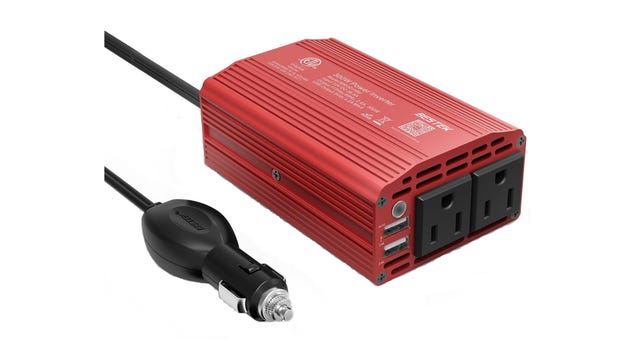
Bestek 300-watt Power Inverter
Best power inverter overall.
Bestek is a brand with a strong reputation that makes it an easy recommendation and, at 300 watts, this is about as powerful an inverter as I'd be comfortable connecting to a car's accessory power. The unit features two 110-volt AC outlets and a pair of 2.4-amp USB ports that should make easy work of charging laptops, tablets and other electronics on the go. The aluminum design with an integrated cooling fan is good for keeping the internal electronics cool and strong enough to hold up to abuse, though you will have to find somewhere to mount the bulky box -- preferably under a seat, using screws or strong adhesive.

Bestek 75-watt Power Inverter
Best portable power inverter.
The Bestek 75-watt inverter plugs directly into the 12-volt power output point, putting a single AC outlet and dual USB ports right there on your dashboard or center console -- though, depending on how recessed your car's 12-volt power outlet is, you may prefer a corded unit. The compact design makes it easy to toss in a bag and move from car to car and still manages to integrate a cooling fan. At 75 watts of peak power, it's the least powerful unit on this list of best car power inverters, but unless you have a Pro level laptop, this may be all the wattage you need to charge most small electronics.

SuperOne 150-watt Car Power Inverter
Best compact power inverter.
The cup-shaped SuperOne car inverter drops into your car's cup holder, solving the problem of "where to mount your inverter." After plugging it into a 12-volt cigarette lighter plug, it provides 150 watts to a single AC outlet and dual USB ports. There are even a pair of 12-volt passthrough power points, so you can still plug in other accessories like radar detectors or dash cams. Of course, taking up a cupholder leaves you with less room for tasty beverages, and I'm a bit dubious about the 150-watt claim (it's probably closer to 75 or 80 watts according to some customer estimates), but this car power inverter should work well enough for light loads.
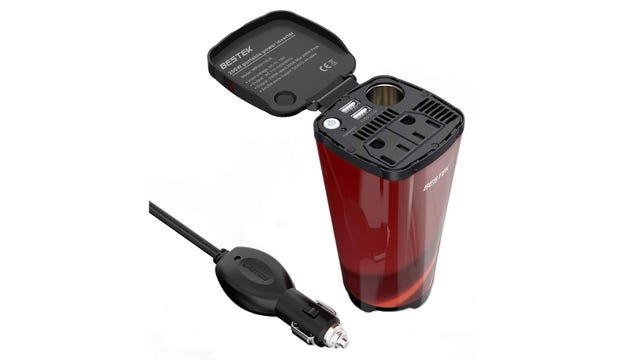
Bestek 200-watt Car Power Inverter
Most convenient power inverter.
Here's another cup-shaped AC power inverter. The grande-size design makes more room for internal electronics, stepping up to a 200-watt rating split between a pair of AC outlets. There are also dual USB ports and a single 12-volt pass-through point. I'm not a fan of the cooling fan's position on the bottom of the cup -- it could be blocked by certain cup holder designs -- but I like that the convenient lid on this car power inverter keeps crud out of the outlets when not in use and how the cup shape makes mounting and removal easy.
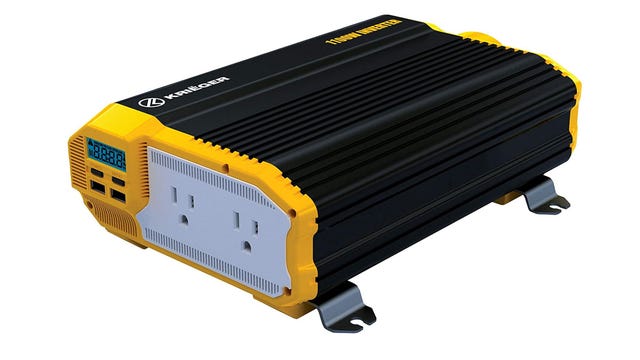
Krieger 1,100-watt 12V Power Inverter
Best power inverter for power users.
Having 1,100 watts of peak power at your disposal from a car power inverter should be plenty for running small appliances -- such as a vacuum cleaner, a small coffee maker or power tool battery chargers. The Kreiger power inverter features two AC outlets and dual USB ports along with an LCD to monitor power output and performance. Professional installation is recommended for such a powerful unit. With so much current being drawn, you'll also appreciate the wired remote power switch that can deactivate the unit when not in use, preserving your car battery.
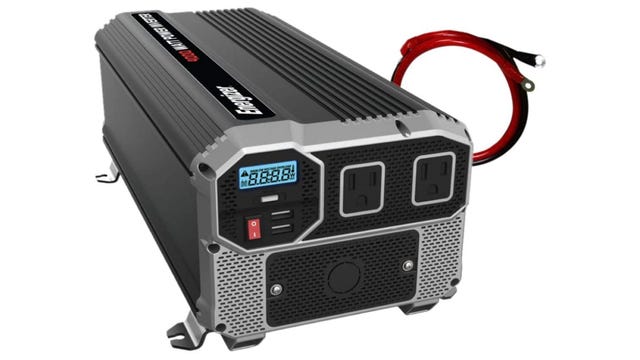
Energizer 4,000-watt Power Inverter
Most powerful inverter.
The Energizer car power inverter is a big beefcake, boasting up to 4,000 watts of power split between its two AC outlets. There are also a pair of 2.4-amp USB ports for charging smaller devices and an LCD screen to monitor all of that current. There are more powerful units out there, but this should be enough to run a toaster oven or a microwave with plenty of headroom and minimal modification to your RV or truck. That said, it's bulky and pricey, and professional installation is recommended.
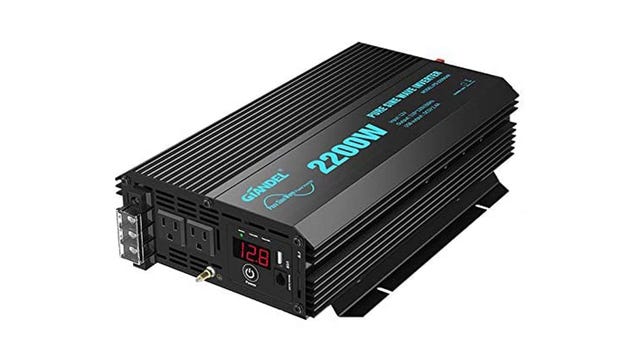
Giandel 2,200-watt Pure Sine Wave Power Inverter
Best pure sine wave for rvs and trucks.
For radio, audio or medical equipment or sensitive electronics, a pure sine wave AC inverter can reduce or eliminate interference and noise you get from more common modified wave units. However, high quality current comes at a price, and pure sine wave inverters like this Giandel unit are significantly more expensive, often twice as pricey, watt for watt. But if you're doing critical work or plugging in delicate or sensitive equipment, it's worth the cost of admission for a sine wave car power inverter. Giandel also offers a 4,000-watt version of its pure sine wave inverter for around $750.
Comparison of the best car power inverters for 2022
What is a power inverter.
A car power inverter is a device that takes the direct current power that your car's battery and alternator use and converts it to alternating current required for many home appliances and electronics. Specifically, we're going from 12-volt DC power to 110-volt AC power, terminating most often in the familiar NEMA 5-15 Type-B grounded outlet like the ones found around your home.
With a car power inverter of the appropriate wattage, you'll be able to plug in and power devices and appliances designed for use at home or in the office -- from laptop and drone chargers to small blenders and coffee makers -- for use on the go and off the grid.
What to look for in a car power inverter?
When shopping for an AC inverter, you should first consider what you plan on plugging in. Do you just want to be able to juice your laptop on the way to work or are you looking to run a toaster oven while glamping? This will help you to determine what wattage to aim for and how many power outlets and USB ports the inverter should possess.
Almost every car power inverter on this list also features a USB port or two, handy for charging phones, tablets or small electronics without occupying one of the main AC power ports. Some also have 12-volt pass-through outlets, allowing other automotive accessories, such as dash cams and radar detectors to be plugged in.
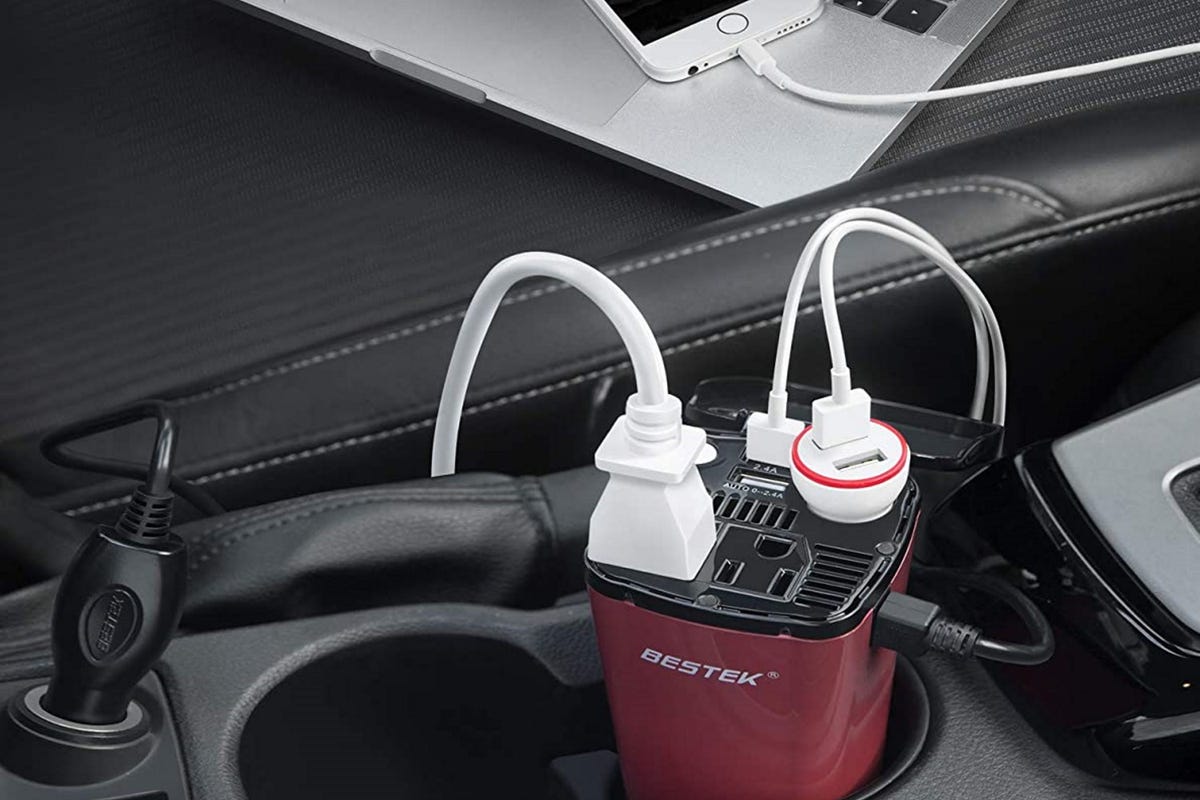
You'll need to consider your power usage, design and the space available in your vehicle when choosing the right power inverter.
How much power is enough?
Car power inverters are usually categorized based on the wattage they put out, tending to get more expensive the higher wattage and more AC outlets they offer. A small power inverter usually puts out around 75 to 150 watts, which is usually enough to charge most laptops, low-power game consoles like the Nintendo Switch, camera and drone battery chargers and the like. Stepping up to 300 to 500 watts lets you charge larger, more powerful electronics and usually gets you a second AC outlet, letting you plug in two devices at the same time.
At 1,000 watts, there's enough juice to run a coffee maker, blender or small microwave oven. The largest inverters covered by this guide top out at around 4,000 watts. They usually offer two to four AC power outlets, which should be enough to run multiple small appliances or even larger ones, like toaster ovens, certain power tools and saws or a powerful gaming PC with multiple monitors. Big power inverters such as these are great for RVs, trucks and trailers that spend a lot of time on the road.
Do you need pure sine wave current?
In addition to how much wattage a power inverter produces, you may also want to pay attention to the quality of the current produced. When viewed through an oscilloscope, alternating current should look like a sine wave alternating smoothly between negative and positive polarity. However, the AC produced by most inexpensive car power inverters is a modified wave that looks more like stair steps back and forth between the two polarities. For sensitive equipment, like radios or medical equipment this stepping wave can cause noise or interference that is undesirable.
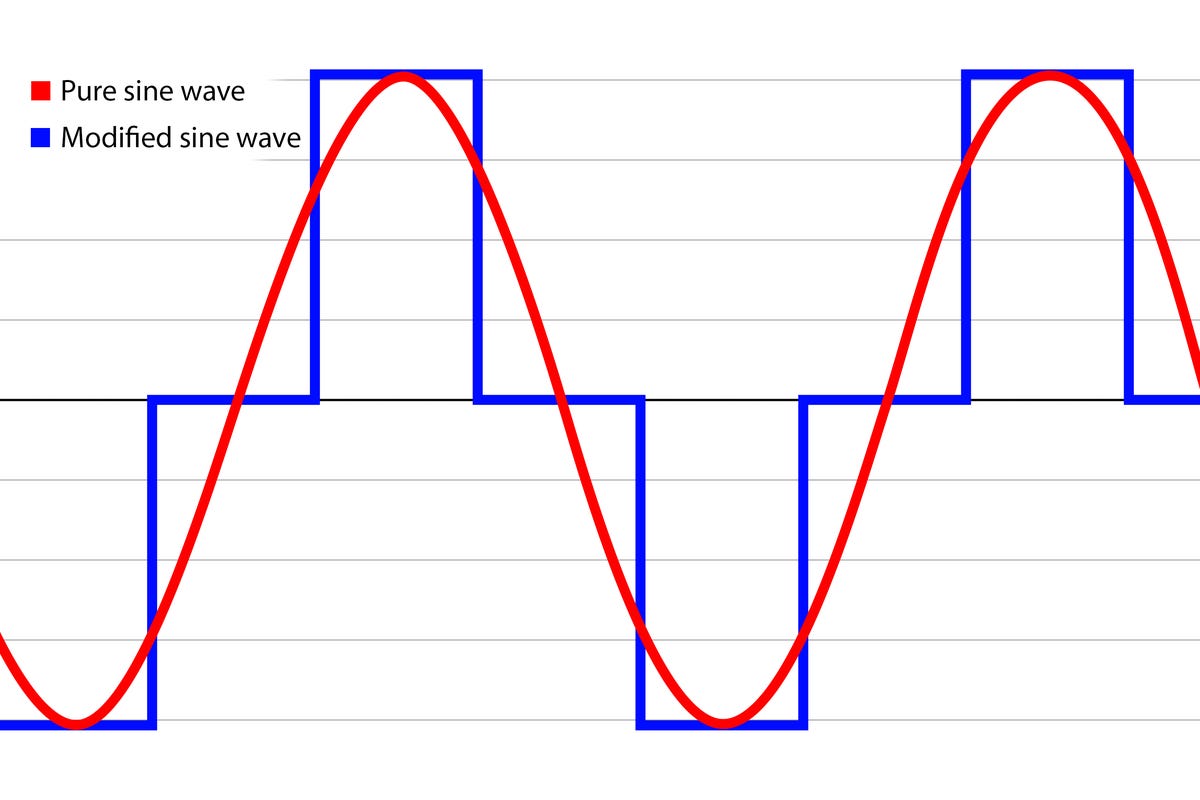
Most "pure sine wave" inverters still don't produce perfectly smooth AC curves, but are markedly cleaner than modified wave units.
The solution to this problem is a pure sine wave inverter that uses special circuitry to create that smooth AC wave and eliminate or reduce noise. Pure sine wave inverters are, however, significantly more expensive -- often twice as expensive watt-for-watt than a modified wave inverter. So, if you're only running simple appliances where clean current is necessary or even electronics, like laptops or gaming consoles, that have their own power supply, you can often skip the modified sine wave power inverter. (Ironically, these power bricks and adapters for most electronics usually have internal rectifiers that convert the AC power back to DC that the device can use.)
How do you install a car power inverter?
More wattage also somewhat complicates installation. Below 150 watts, you can usually just plug the inverter into your car's 12-volt outlet -- what we used to call the cigarette lighter plug. But most cars aren't rated for high wattage accessory power, so a 4,000-watt inverter would just blow the fuse. So, power inverters above 300 watts usually require a direct connection to the vehicle's battery and their own fuse. That can be as simple as simple alligator-type clips that connect to the battery clamp terminals, but a hardwired connection is safest and best. That means having an experienced installer handle installation if you're not comfortable doing so yourself.
Very high wattage power inverters or applications where extended use may be required, further modification may also be required. For example, adding a larger battery, beefier wiring or perhaps even a second battery for overnight use in an RV or overlanding truck. Remember, an inverter doesn't create power, it just converts it from your car's reserves. Powering your gadgets is good, but you'll want to make sure there's enough amperage left in the car battery to crank up when you're done. Again, an experienced installer will be able to help with your specific needs.

- Patio, Lawn & Garden
- Generators & Portable Power
- Solar & Wind Power
- Solar & Wind Power Inverters
Add to your order

- No Additional Cost: You pay nothing for repairs – parts, labor, and shipping included.
- Coverage: Plan starts on the date of purchase. Malfunctions covered after the manufacturer's warranty. Power surges covered from day one. Real experts are available 24/7 to help with set-up, connectivity issues, troubleshooting and much more.
- Easy Claims Process: File a claim anytime online or by phone. Most claims approved within minutes. We will send you an e-gift card for the purchase price of your covered product. In some instances, we will replace or repair it.
- Product Eligibility: Plan must be purchased with a product or within 30 days of the product purchase. Pre-existing conditions are not covered.
- Terms & Details: More information about this protection plan is available within the “Product guides and documents” section. Simply click “User Guide” for more info. Terms & Conditions will be available in Your Orders on Amazon. Asurion will also email your plan confirmation with Terms & Conditions to the address associated with your Amazon account within 24 hours of purchase.
- Buy a lot of stuff on Amazon? Tons of items eligible for coverage, from the latest tech like laptops, game consoles, and TVs, to major appliances, sporting goods, tools, toys, mattresses, personal care, furniture, and more.
- Accidents happen. That’s why for your portable products we cover accidental damage from handling such as drops, spills and cracked screens. We also cover electrical and mechanical malfunctions, power surges, and wear and tear.
- Past and future purchases covered. 30 days after you are enrolled, all eligible past purchases (up to 1 year prior to enrollment) and future eligible purchases made on Amazon will be covered by your plan as long as you are enrolled.
- Fast, easy claims. Frustration-free claims, with most filed in minutes. We will fix it, replace it, or reimburse you with an Amazon e-gift card for the purchase price of your product (excluding tax). File at Asurion.com/amazon.
- No hidden fees. For just $16.99 a month + tax you’re covered for up to $5,000 in claims per 12-month period. *THIS PROGRAM IS MONTH-TO-MONTH AND WILL CONTINUE UNTIL CANCELED* Coverage for all products ends 30 days after the plan is canceled. Cancel any time.

Enjoy fast, free delivery, exclusive deals, and award-winning movies & TV shows with Prime Try Prime and start saving today with fast, free delivery
Amazon Prime includes:
Fast, FREE Delivery is available to Prime members. To join, select "Try Amazon Prime and start saving today with Fast, FREE Delivery" below the Add to Cart button.
- Cardmembers earn 5% Back at Amazon.com with a Prime Credit Card.
- Unlimited Free Two-Day Delivery
- Streaming of thousands of movies and TV shows with limited ads on Prime Video.
- A Kindle book to borrow for free each month - with no due dates
- Listen to over 2 million songs and hundreds of playlists
- Unlimited photo storage with anywhere access
Important: Your credit card will NOT be charged when you start your free trial or if you cancel during the trial period. If you're happy with Amazon Prime, do nothing. At the end of the free trial, your membership will automatically upgrade to a monthly membership.
Return this item for free
Free returns are available for the shipping address you chose. You can return the item for any reason in new and unused condition: no shipping charges
- Go to your orders and start the return
- Select the return method
2 Year Electronics Protection Plan
3 year electronics protection plan, asurion complete protect: one plan covers all eligible past and future purchases on amazon.

Image Unavailable

- To view this video download Flash Player
2000 watt Solar Power Inverter, Solar Power Inverter 12V DC to 110V-120V AC Converter with 3 AC Outlets 2 USB Charging Port, LCD Display for Off-Grid Solar Power System, RV, Truck, Home
Purchase options and add-ons, about this item.
- LCD display: The Battery Converter Inverter have 3 AC outlets 2 USB Charging Port for charging larger devices such as laptops and electric stew,intelligent LCD display, convenient for you to know the battery status and the load capacity.
- Home or Outdoor Using :Advanced Safety Protection Power Inverter is ideal for use on vacations, work trips, camping and solar setup . You just connect the inverter to a battery and plug your AC devices into the inverter, and you've got portable power.
- Safety Protection:The solid and durable aluminum housing can provide protection from drops and bumps and stand up to harsh environments. Loddery Power Inverter Has over-voltage protection, over-load protection, low voltage protection, over-current protection, over-temperature protection and short circuit protection to safety use.
- Low Temperature operation:High-performance cooling fan helps keep the inverter running at a low temperature and extend the life span of it.
- Guarantee:Our power inverter has Product safety Certification,We provide 24-hours friendly customer service. (Please use in well-ventilated, dry area.)

Buy it with

Customers also viewed these products

Product information
Warranty & support, product description.
Solar Power Inverter High Efficiency Sine Wave Inverter Home Car RV Solar Power Converter with LCD Display DC 12V to 110V AC 2000W Specifications Continuous power: 850-950W Peak power: 1600-2000W Input voltage: DC 12V Output voltage: AC 100V-120V Conversion efficiency: 80% Output frequency: 60HZ±2HZ Plug: American Standard Output waveform: Modified sine wave Package weight: 1500g Package size: 28 * 14.5 * 6cm
Looking for specific info?
Customer reviews.
Customer Reviews, including Product Star Ratings help customers to learn more about the product and decide whether it is the right product for them.
To calculate the overall star rating and percentage breakdown by star, we don’t use a simple average. Instead, our system considers things like how recent a review is and if the reviewer bought the item on Amazon. It also analyzed reviews to verify trustworthiness.
No customer reviews
- Amazon Newsletter
- About Amazon
- Accessibility
- Sustainability
- Press Center
- Investor Relations
- Amazon Devices
- Amazon Science
- Sell on Amazon
- Sell apps on Amazon
- Supply to Amazon
- Protect & Build Your Brand
- Become an Affiliate
- Become a Delivery Driver
- Start a Package Delivery Business
- Advertise Your Products
- Self-Publish with Us
- Become an Amazon Hub Partner
- › See More Ways to Make Money
- Amazon Visa
- Amazon Store Card
- Amazon Secured Card
- Amazon Business Card
- Shop with Points
- Credit Card Marketplace
- Reload Your Balance
- Amazon Currency Converter
- Your Account
- Your Orders
- Shipping Rates & Policies
- Amazon Prime
- Returns & Replacements
- Manage Your Content and Devices
- Recalls and Product Safety Alerts
- Conditions of Use
- Privacy Notice
- Consumer Health Data Privacy Disclosure
- Your Ads Privacy Choices
Welcome to our store
Item added to your cart

VEVOR Power Inverter 2000W Modified Sine Wave Inverter DC24V to AC120V Car Converter with USB Port LCD Display Remote Controller LED Indicator AC Outlets Inverter for Car RV Truck Boat Travel Camping
Couldn't load pickup availability
Brand Introduction
Product description, specifications, packagecontent.
- Choosing a selection results in a full page refresh.
- Opens in a new window.

IMAGES
VIDEO
COMMENTS
1.5 POTEK 500W AC Car Converter with Digital Display. 1.6 Energizer 500 Watts Power Adapter. 2 Best AC to 12V Adapters. 2.1 Sunforce AC/DC Power Converter. 2.2 Schumacher 12V Power Converter. 2.3 RoyPow AC to DC Adapter 12V Car Cigarette Lighter Socket. 2.4 Cellet Universal AC Wall to DC Car Cigarette Lighter Port.
The function of an inverter is to transform low voltage (12, 24, or 48 Volts) DC electricity into higher voltage (120 Volts) AC power. Your batteries' terminals serve as the inverter's input, and its output is either the main panel of your RV or the air conditioner itself. The manufacturer specifies the input voltage that the inverter can ...
Renogy 3000W Pure Sine Wave Inverter 12V DC to 120V AC Converter for Home, RV, Truck, Off-Grid Solar Power Inverter with Built-in 5V/2.1A USB, AC Hardwire Port, Remote Controller ... 4000 Watt Pure Sine Wave Power Inverter 12V DC to 110V 120V Converter for Family RV Off Grid Solar System Car with Type-C Ports 4 AC Power Outlets Dual USB Ports ...
With the purchase of a metal vent frame, the Turbokool 2B-0001 12 Volt Evaporative Swamp Air Cooler may be roof-mounted over an existing 14′′ x 14′′ roof vent or can replace an existing RV air conditioner. Turbokool's creators claim that it can chill air by 20 to 30 degrees while only using 4.6 amps of 12v electricity.
Whether you're traveling or at home, the Nature Power 5.8 Amp AC to DC Converter is a great tool to have on-hand. The easy-to-use converter can be used any 12V product that is rated 5.8 amps or less and has and can convert a 110-volt AC to 12-volt DC plug. Specs: 5.8 Amp AC to DC Converter Input Power: 110V AC 60/50 Hz Power Output: 5.8 Amps 12 ...
Today we show you our EASY RV inverter setup to power ALMOST your entire RV. We use a Renogy 2000 watt pure sine wave inverter that allows us to plug our RV ...
What We Know About AC/DC Power. In Part 1 of our RV Electricity Series, we discussed the difference between an RV's Alternating Current (AC) and the Direct Current (DC) systems.For a quick refresher, your RV's house batteries supply RV electricity to the DC power systems. The power you receive from the power box at the campground provides AC power.
This item: WF-9865-AD-CB Deck Mount Converter Charger, 65 Amp DC Output with 20 Amp AC Power Cord, Replacement for RV Trailer Camper WF-9800 Series $226.99 $ 226 . 99 Get it as soon as Monday, Nov 27
Buy EGSCATEE 3000W Pure Sine Wave Inverter 12V DC to 110V/120V AC Inverter with 4AC Outlets, 5V/3.4A USB, Remote Control with on-Screen Display, Off-Grid Solar Power Inverter for Truck, Home, Vehicles, RV: Power Inverters - Amazon.com FREE DELIVERY possible on eligible purchases
Dometic PerfectPower DCDC 12 - This inexpensive, ultra-compact converter was designed for running standard 12 V DC appliances on 24 V DC. It is a good choice if you want to connect a 12 V comfort gadget to the 24 V battery of your vehicle.
2000W Car Power Inverter Pure Sine Wave LCD DC 12V to AC 110V RV Car Converter. Your favorite (4238) 98% positive; Seller's other items Seller's other items; Contact seller; US $4.25. 7 bids. Ends in 3d 18h. Condition: New New. Place bid. ... DC/AC, High Voltage Input Protection, Low Voltage Input Protection, On/Off Switch, Over Battery Voltage ...
Another reason the RV air conditioner won't turn on is the faulty thermostat. It is defective if touching its wires to each other turns on the AC system. In the case of a wall-mounted thermostat, use a multimeter to check its voltage. However, you should examine the AC system's control board if both thermostat and capacitors are functioning.
Well, there are a couple of factors at play here. Right now I have 200w of power but I'll be adding another 200w and maybe 500w to 600w depending on what the roof looks like when I remove the AC unit. Expanding the battery bank to 200AH or even 400AH isn't out of the question either. Another factor ...
Compatible Device: AC DC Adapter For JVC RV-NB10 RV-NB10B RVNB10B RVNB10 RV-NB10W RVNB10W Kaboom Dock Woofer Boombox Power Supply Cord Cable Wall Charger 【SAFETY PERFORMANCE】:AC adapter charger has passed the FCC test with certificates. Made of cutting-edge materials and featuring with V-0 grade flame retardant, OVP, OCP, SCP Protection ...
APC® Travel 120V AC/DC Power Inverter Adapter, 75W. No rating value Same page link. ...
Most apap like Resmed Airsense 10 Autoset have optional accessories like a DC converter. If u dont need a humidifier, u can buy an optional side cover to make it a bit more compact. This replaces the humidifier tank.
Best compact power inverter. SuperOne 150-watt Car Power Inverter. $28. Fits into a cupholder, has 12-volt pass-through for connecting other vehicle accessories. May be slightly underpowered ...
Renogy 2000W Pure Sine Wave Inverter 12V DC to 120V AC Converter for Home, RV, Truck, Off-Grid Solar Power Inverter 12V to 110V with Built-in 5V/2.1A USB / Hardwire Port, Remote Controller.
This LCD remote controller with cable and fuses accurately controls the ac to dc converter in the room and open area. Various Application This modified sine wave inverter is ideal for a gift, cell phone, laptop, electric light, digital camera, breast pump, TV, electrical tools, microwaves, etc.